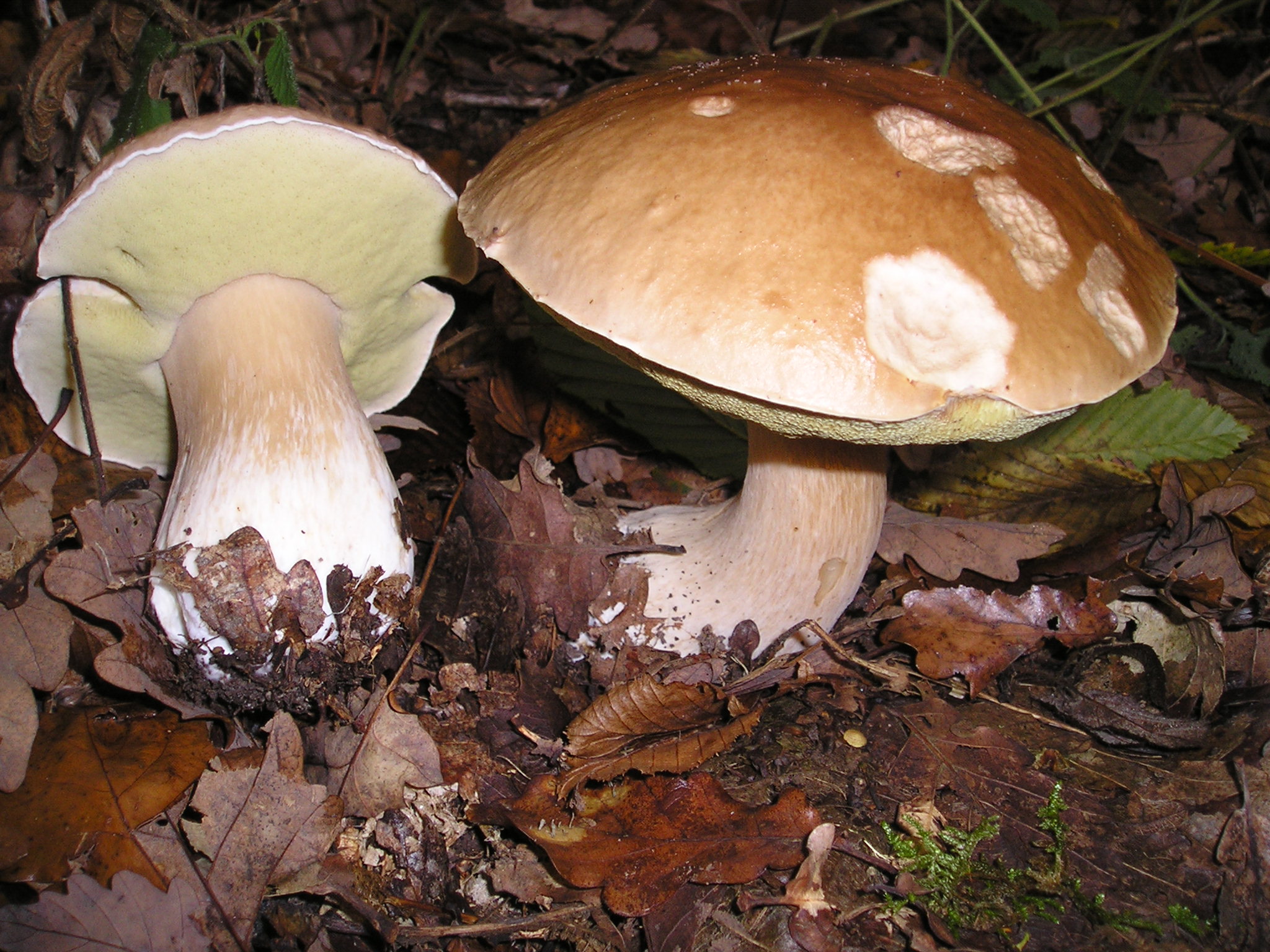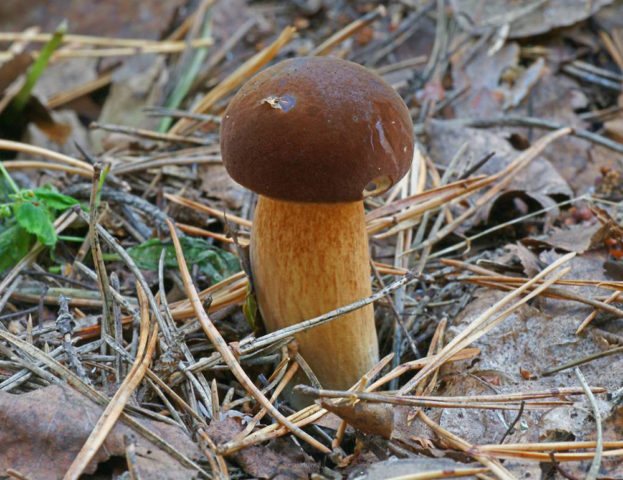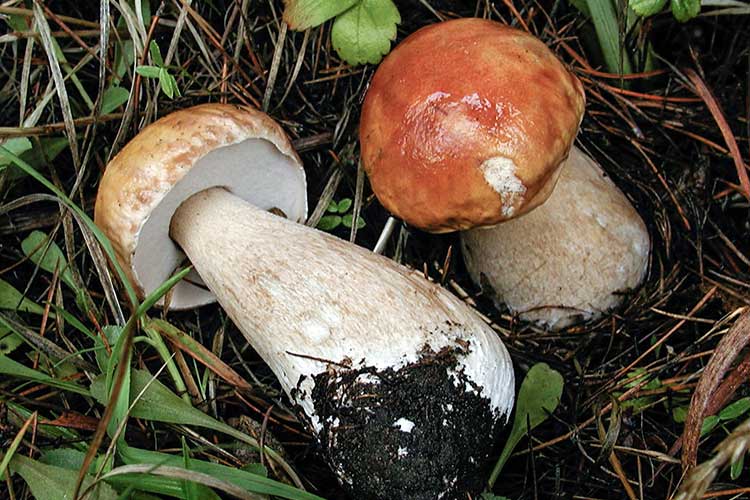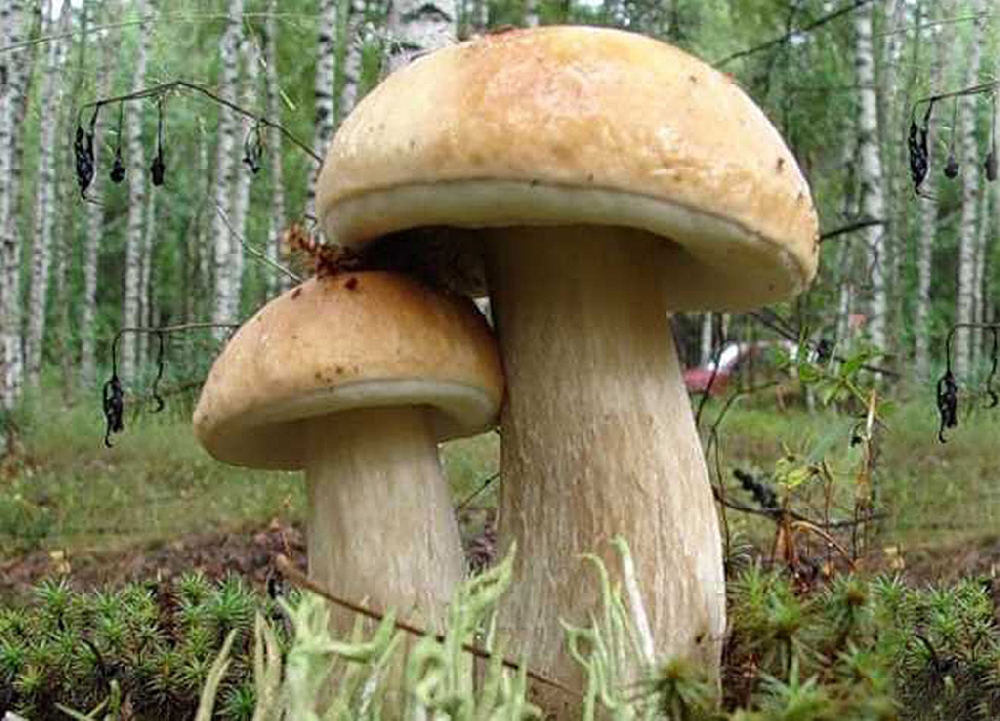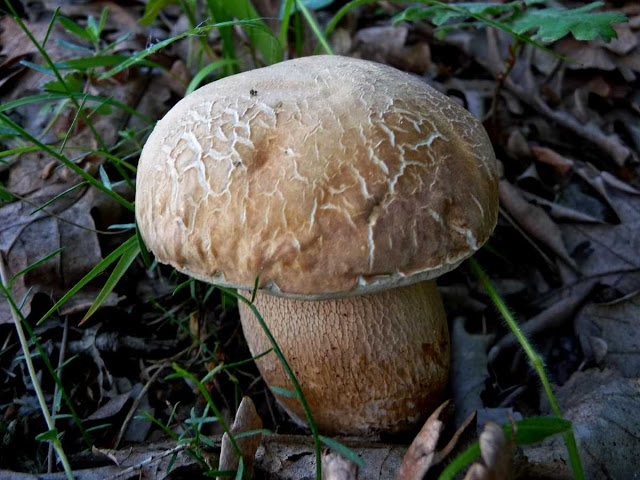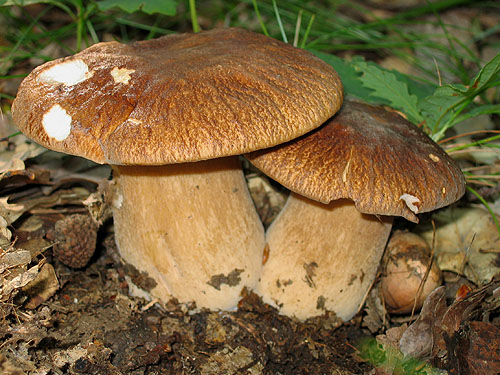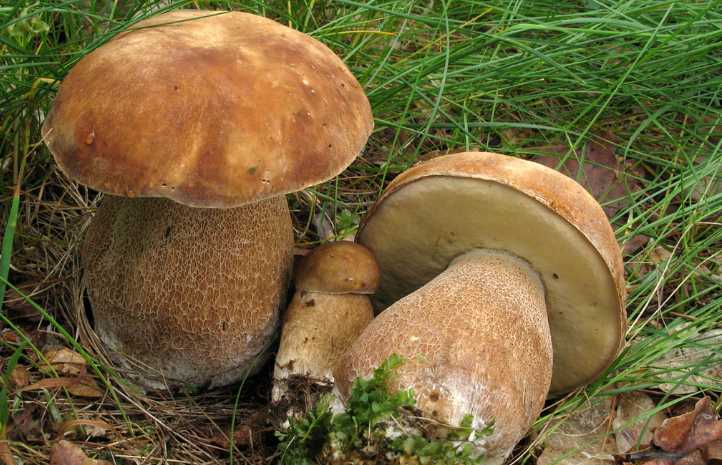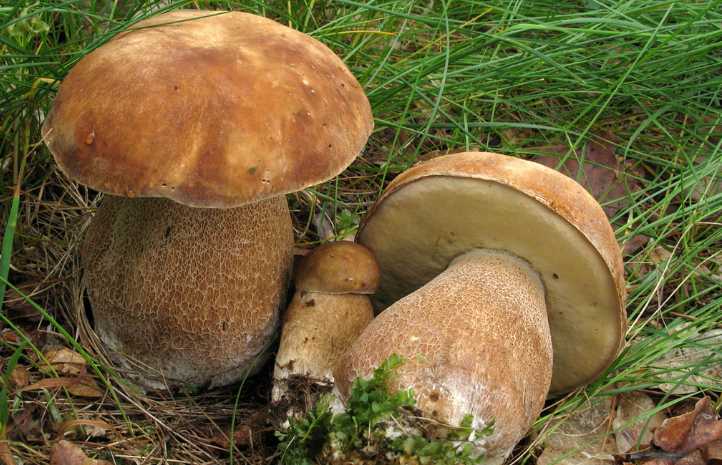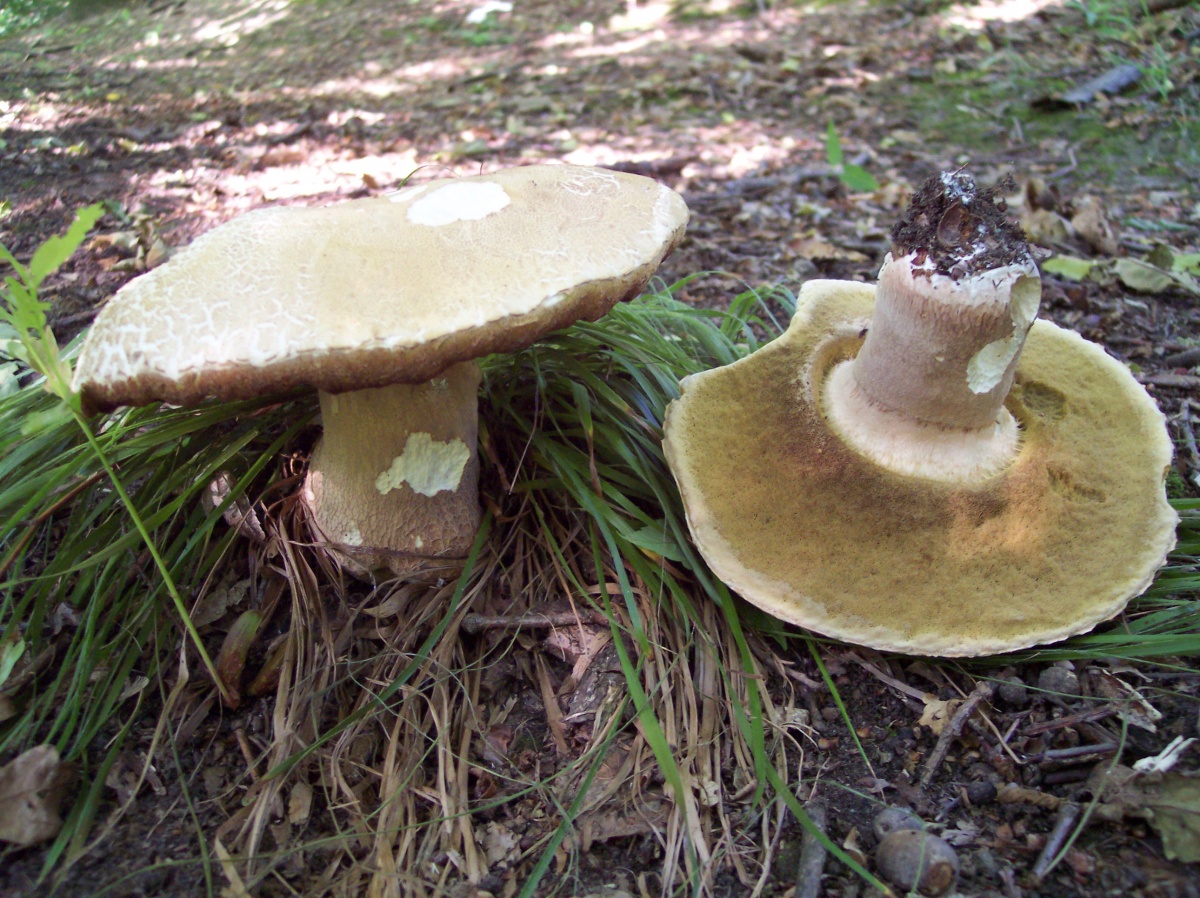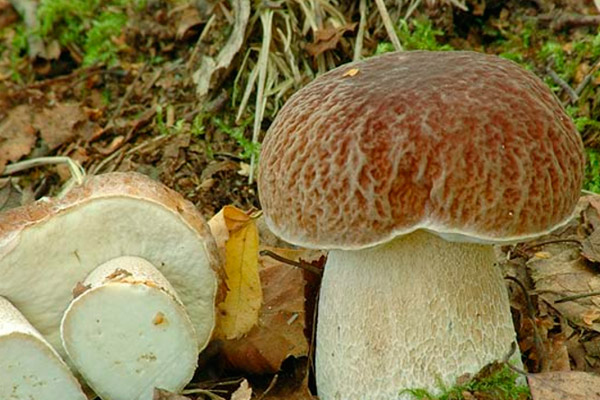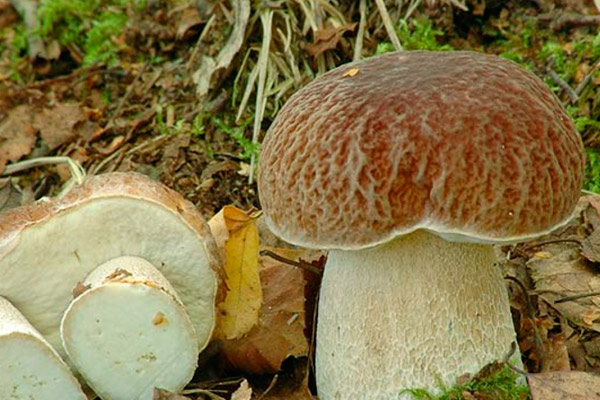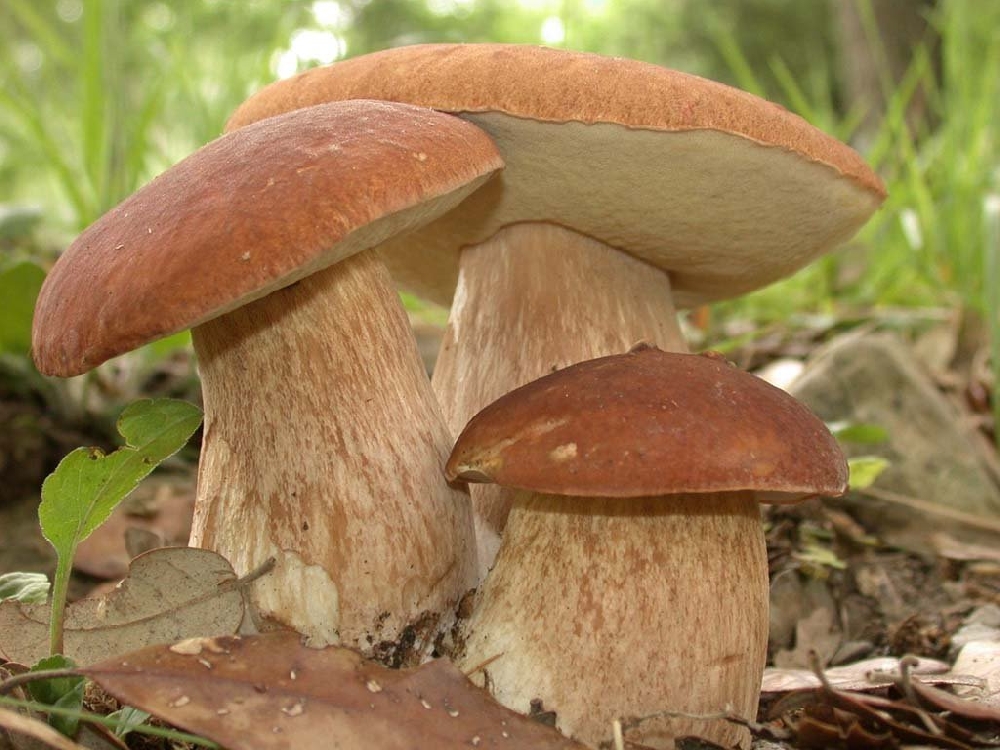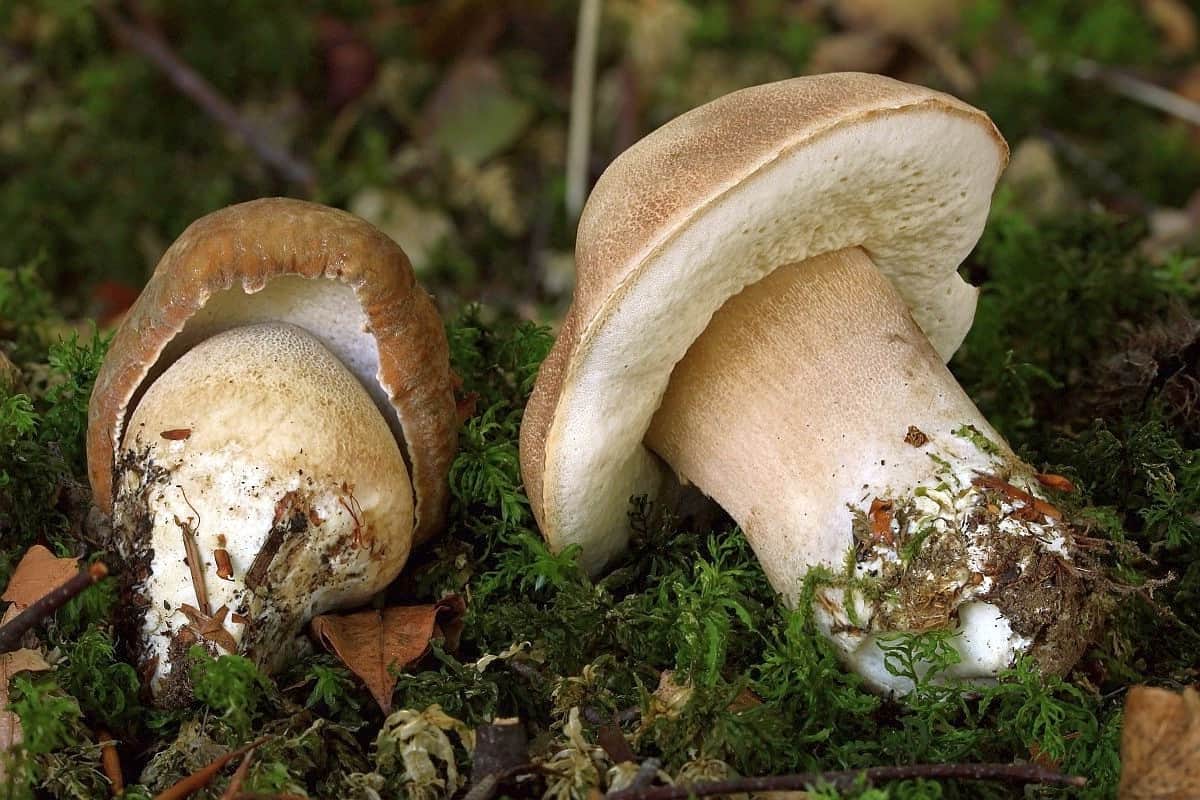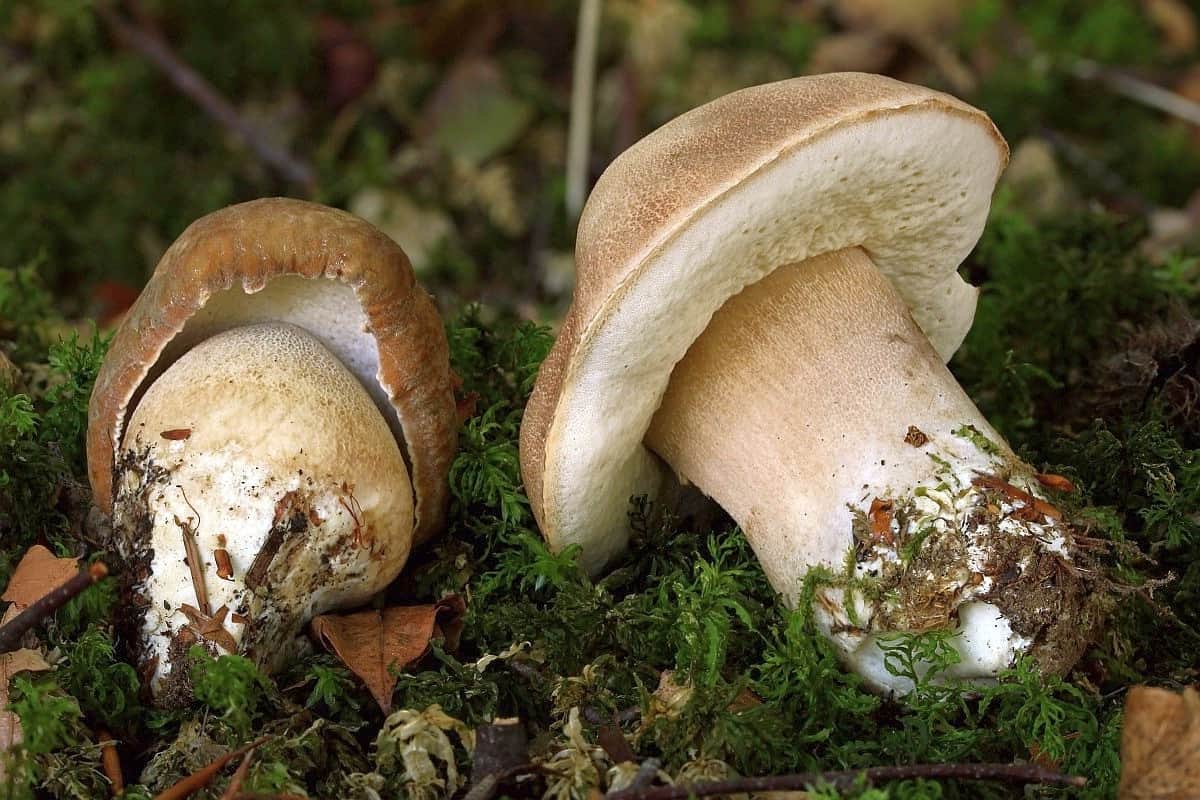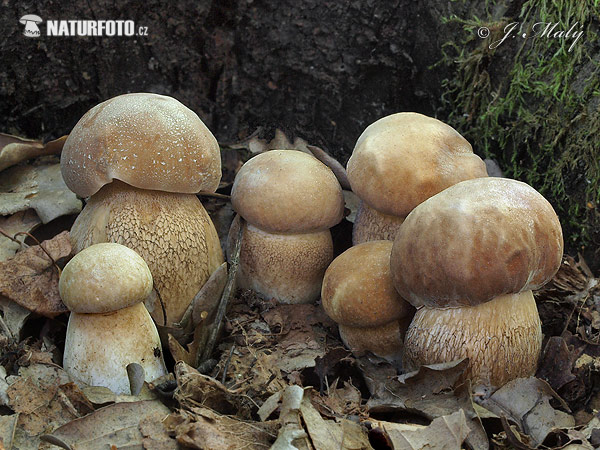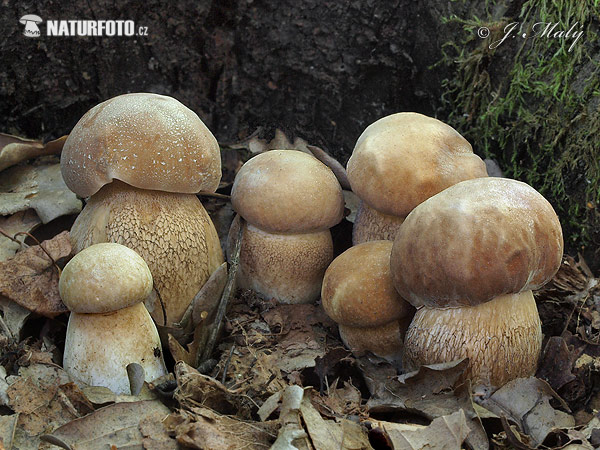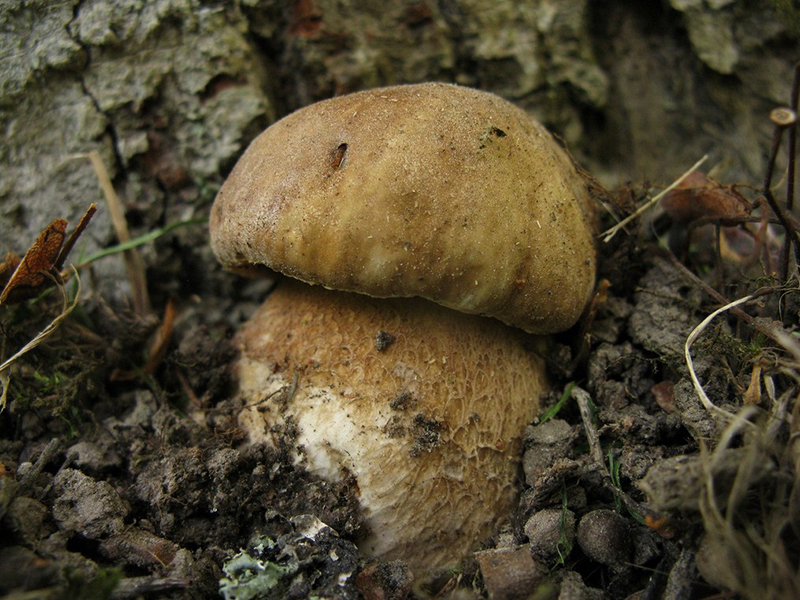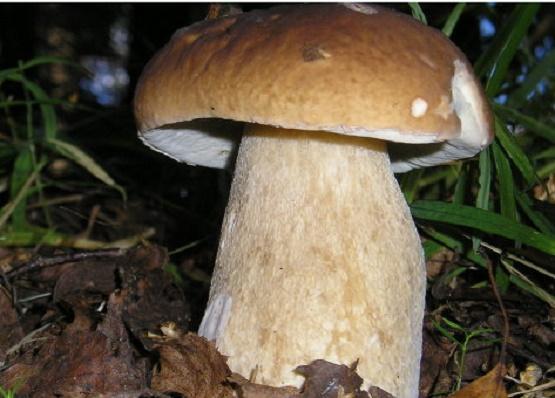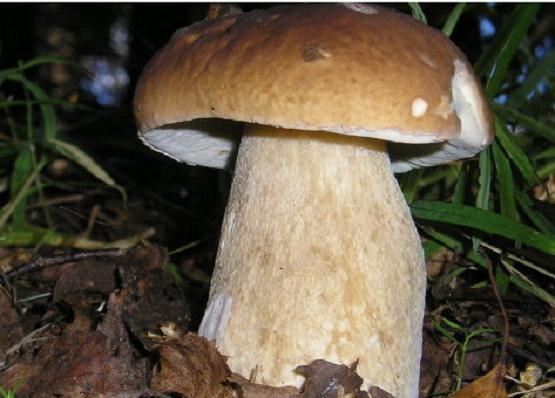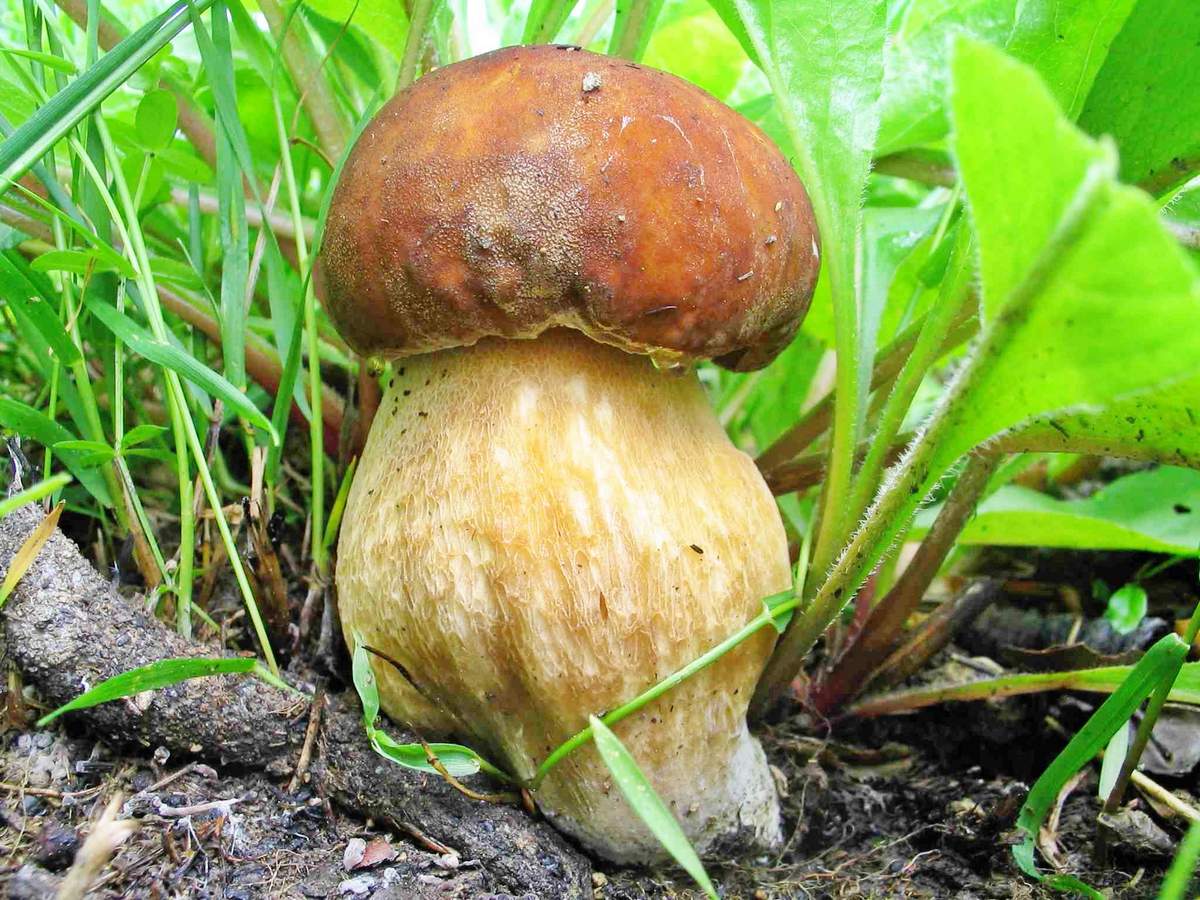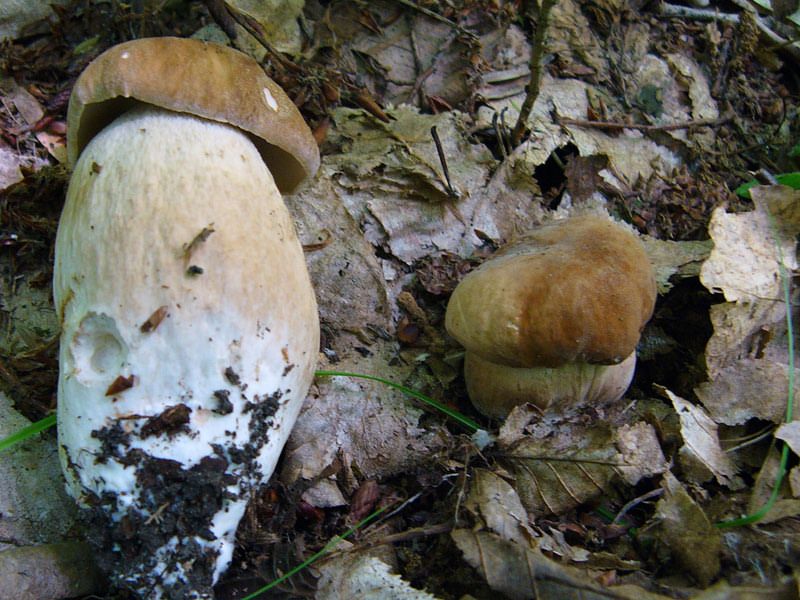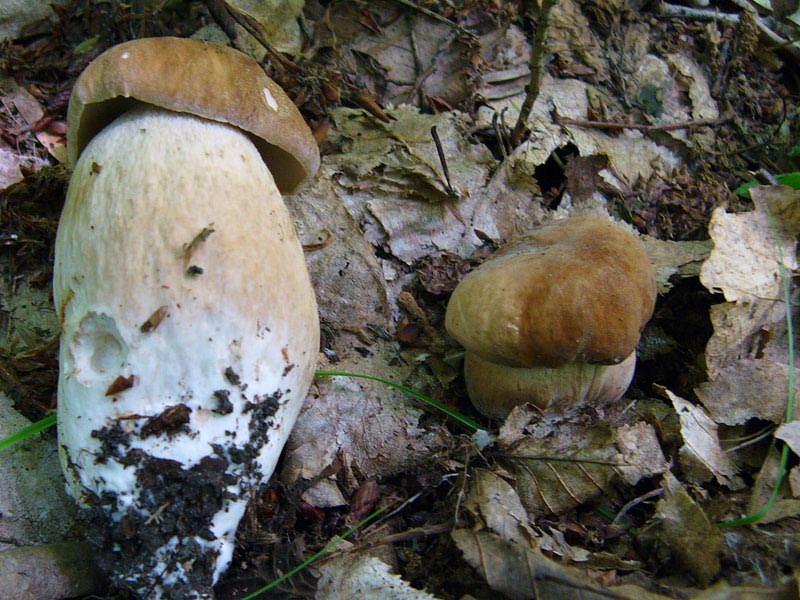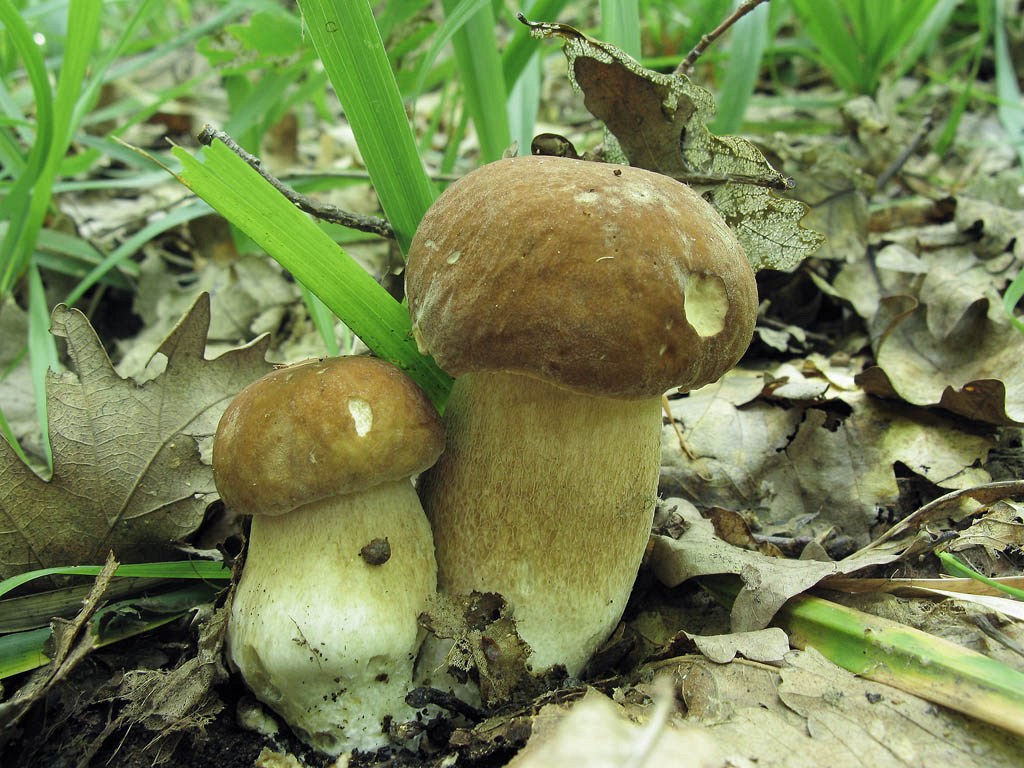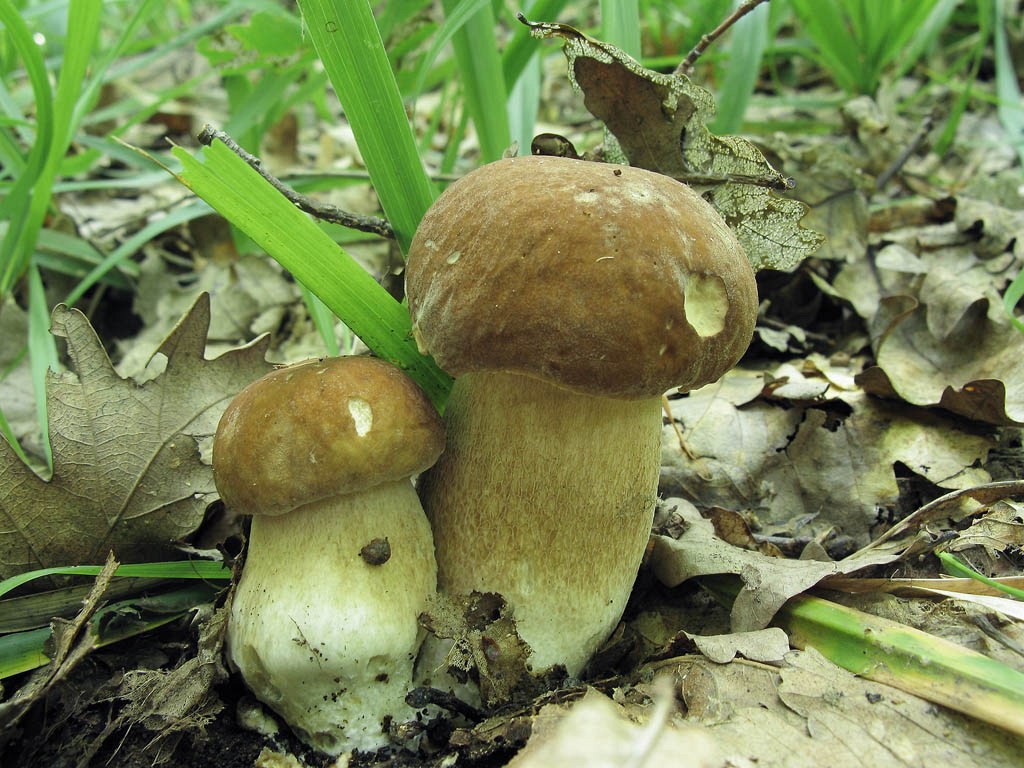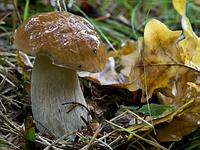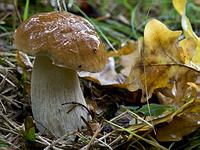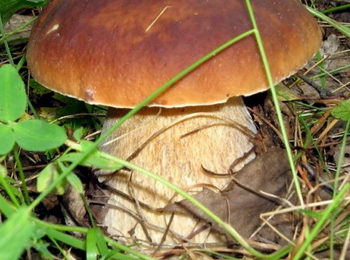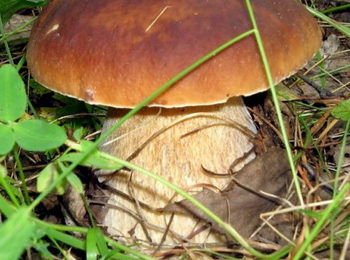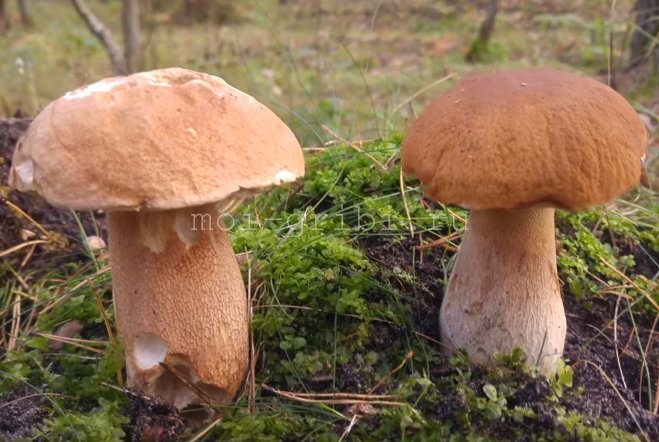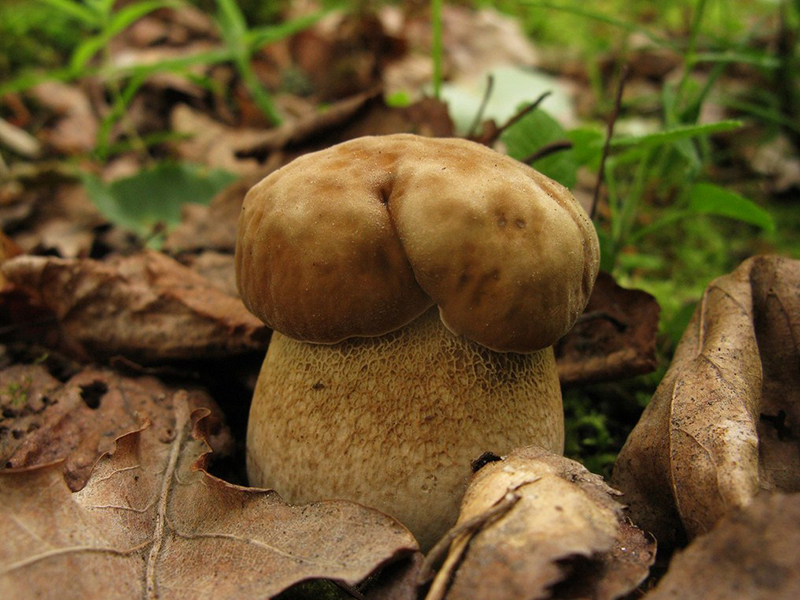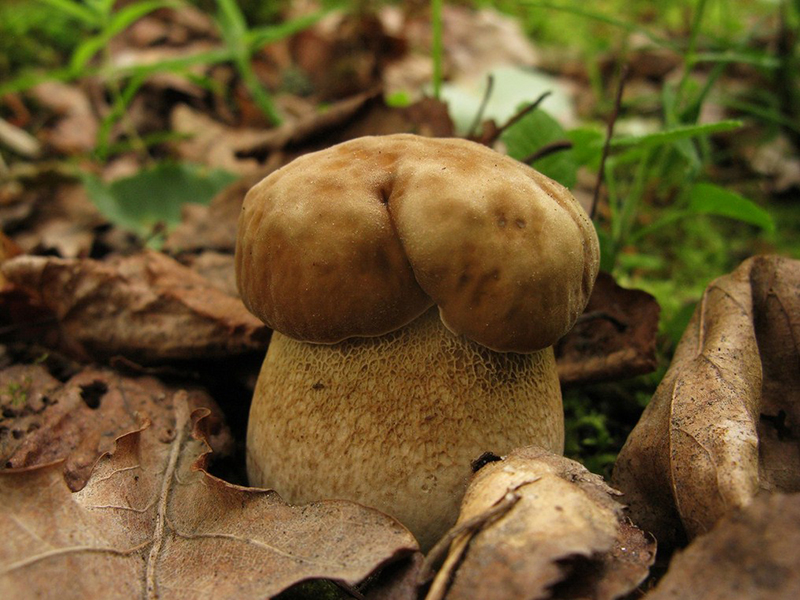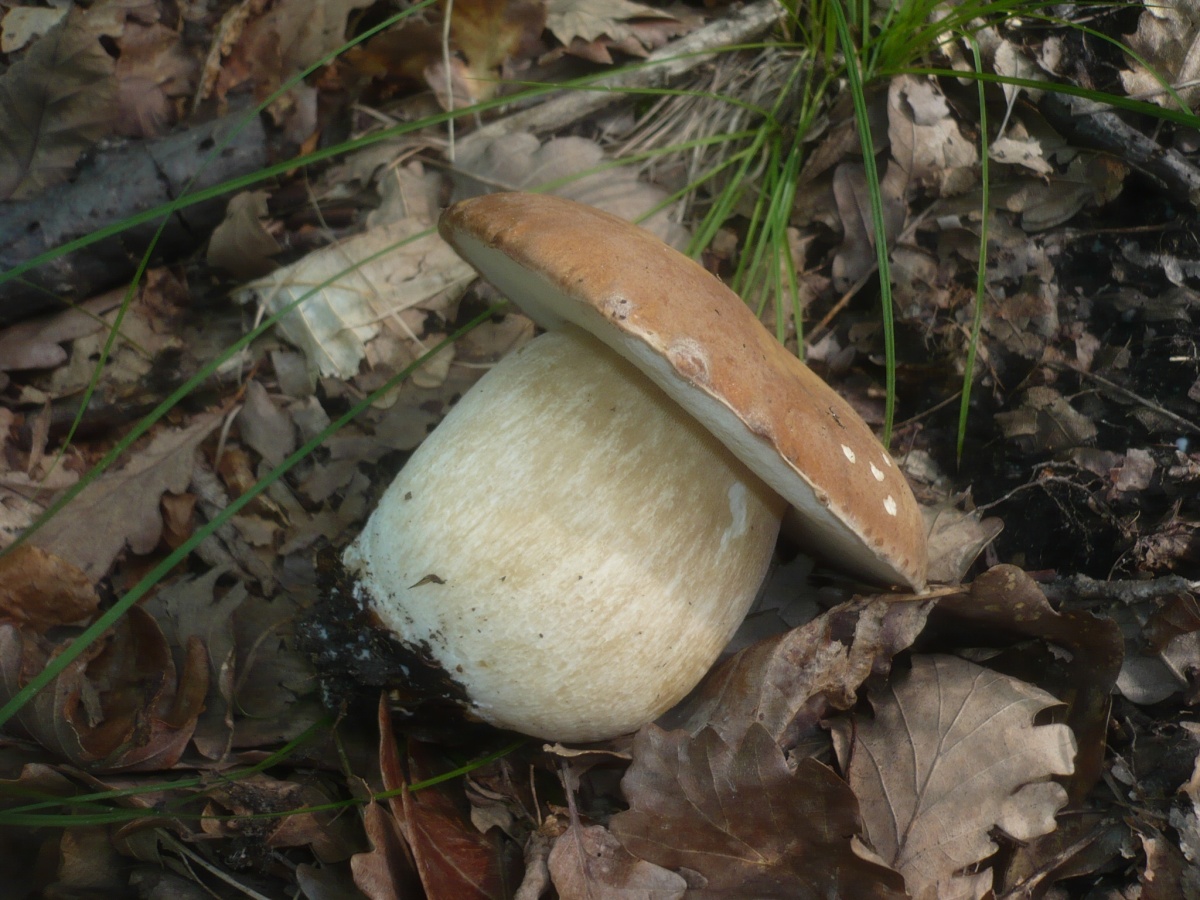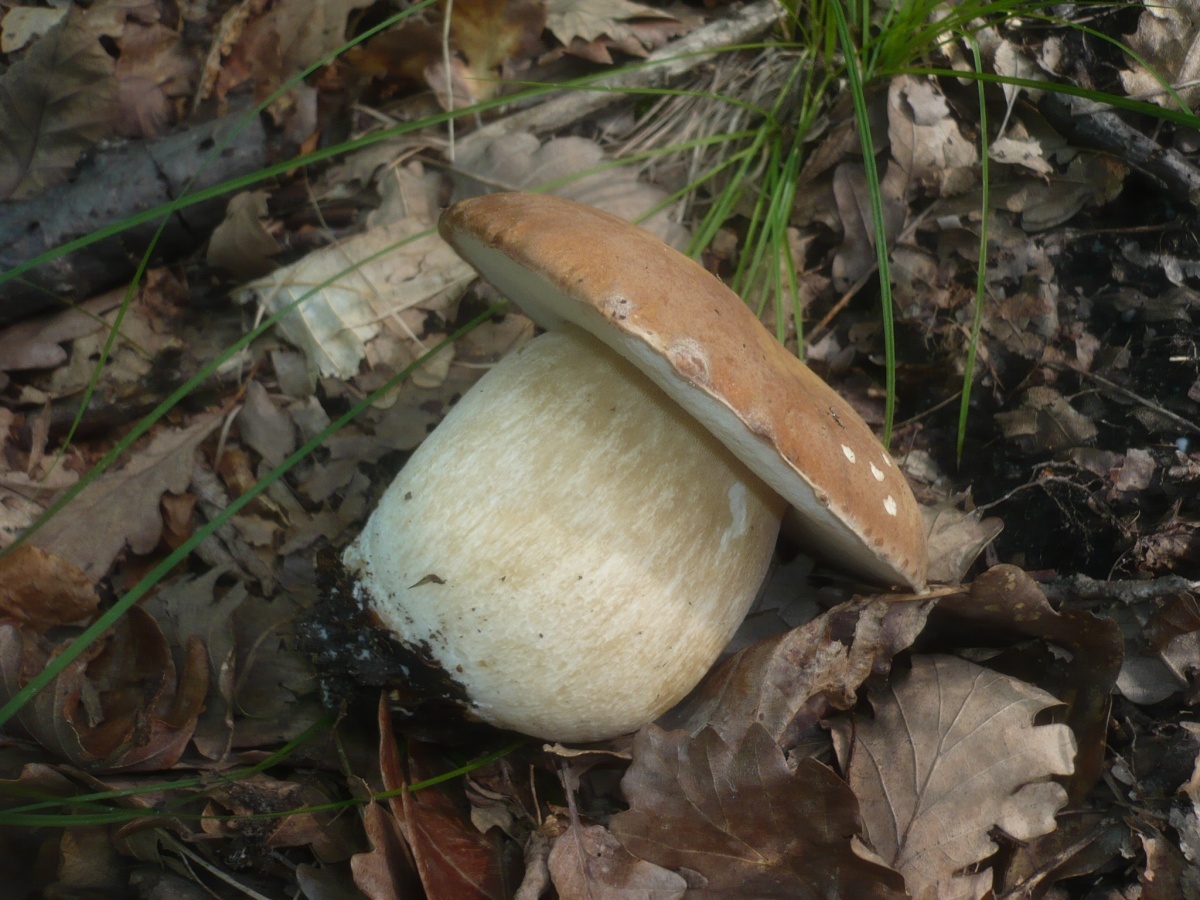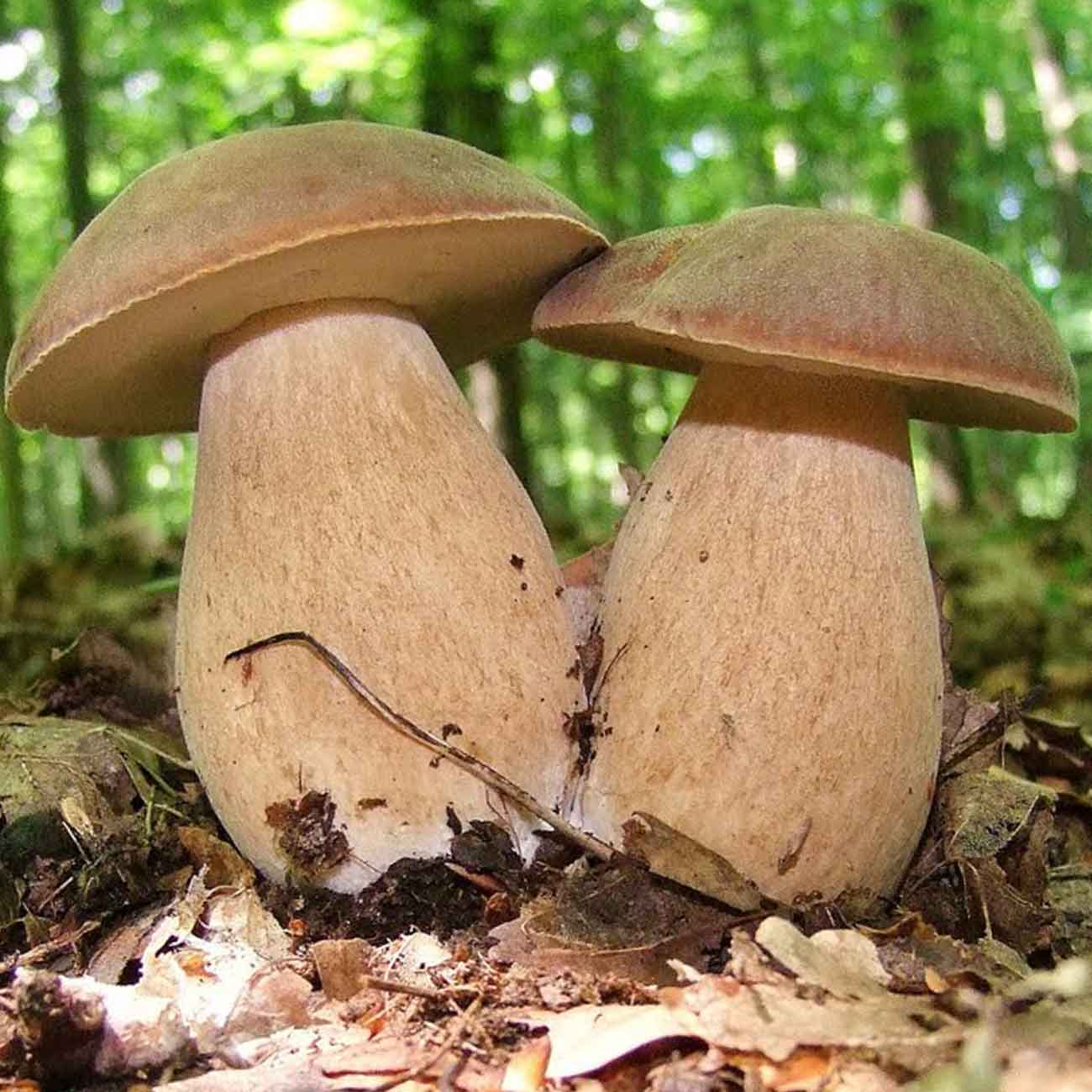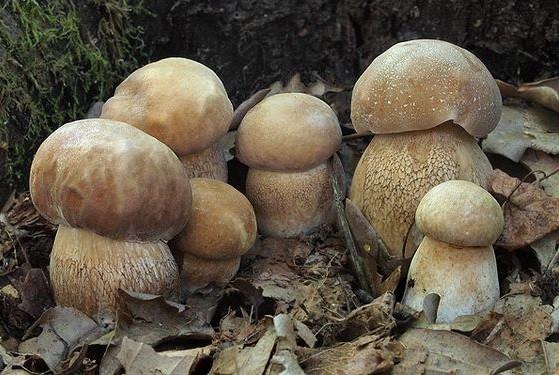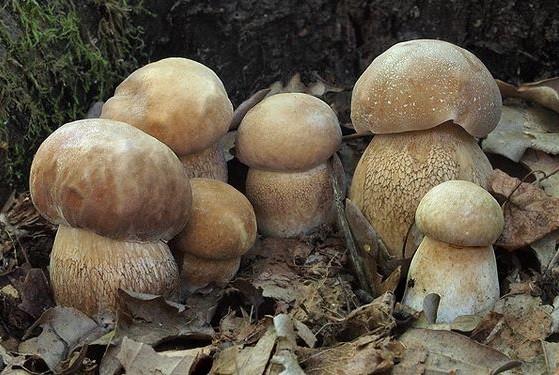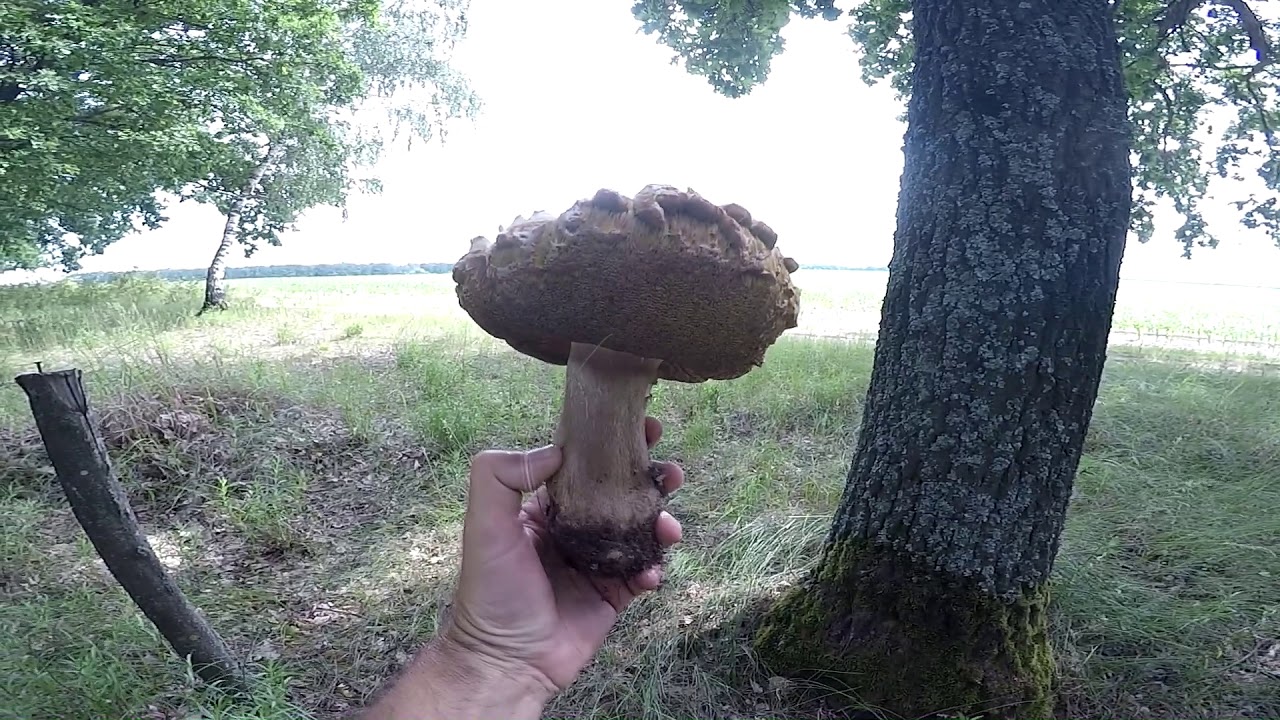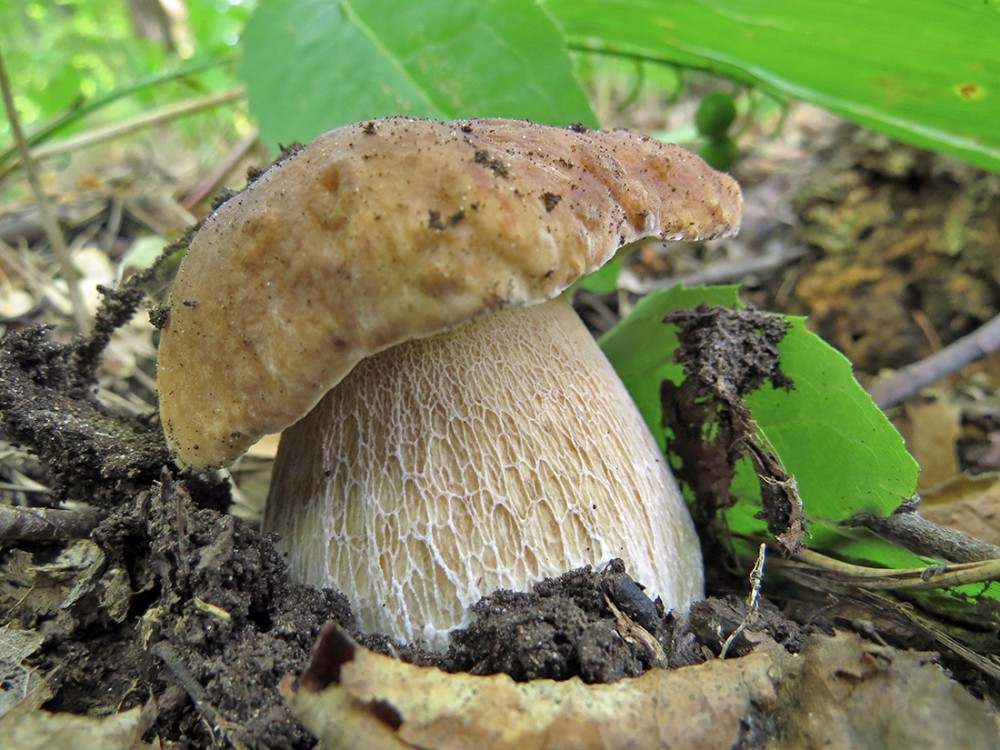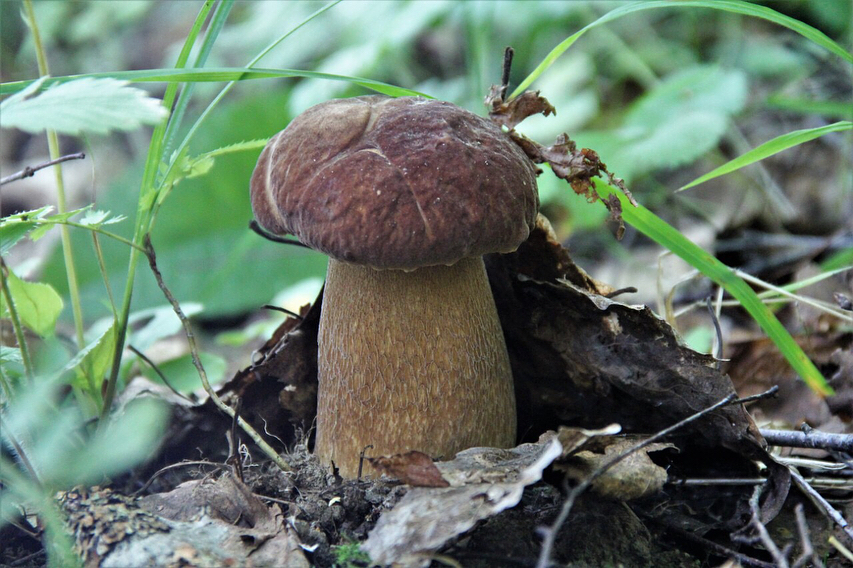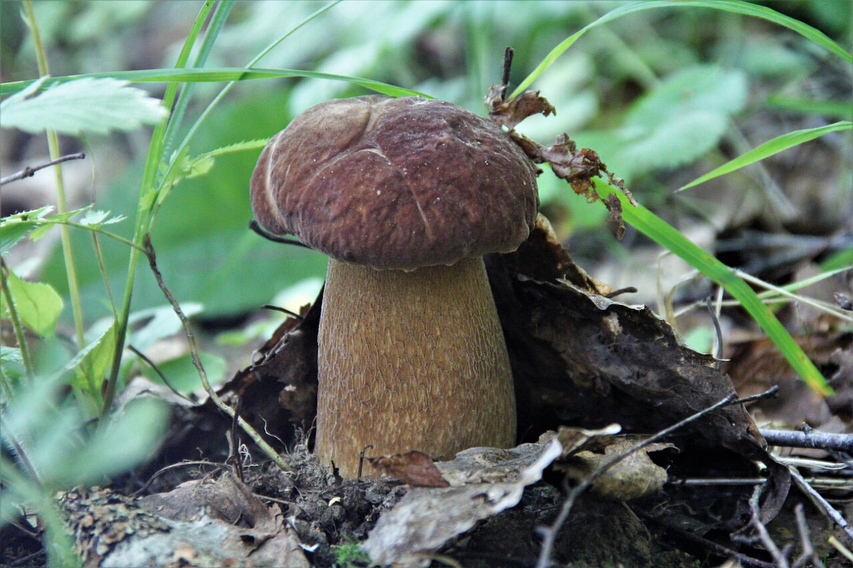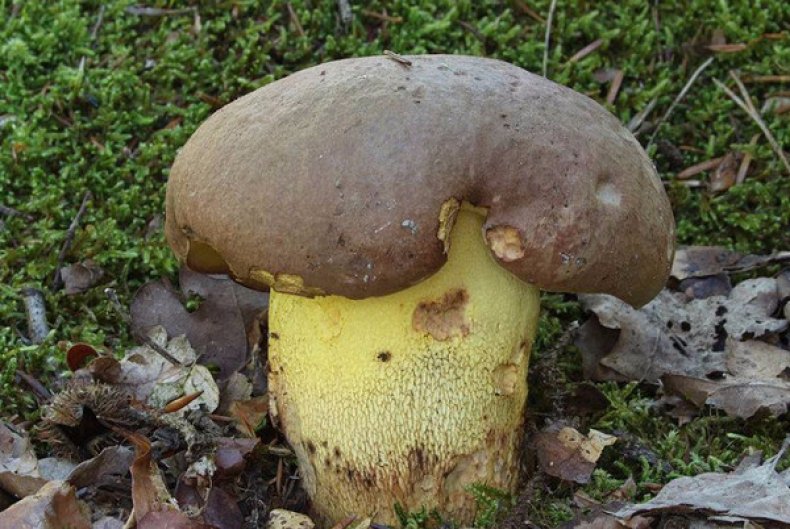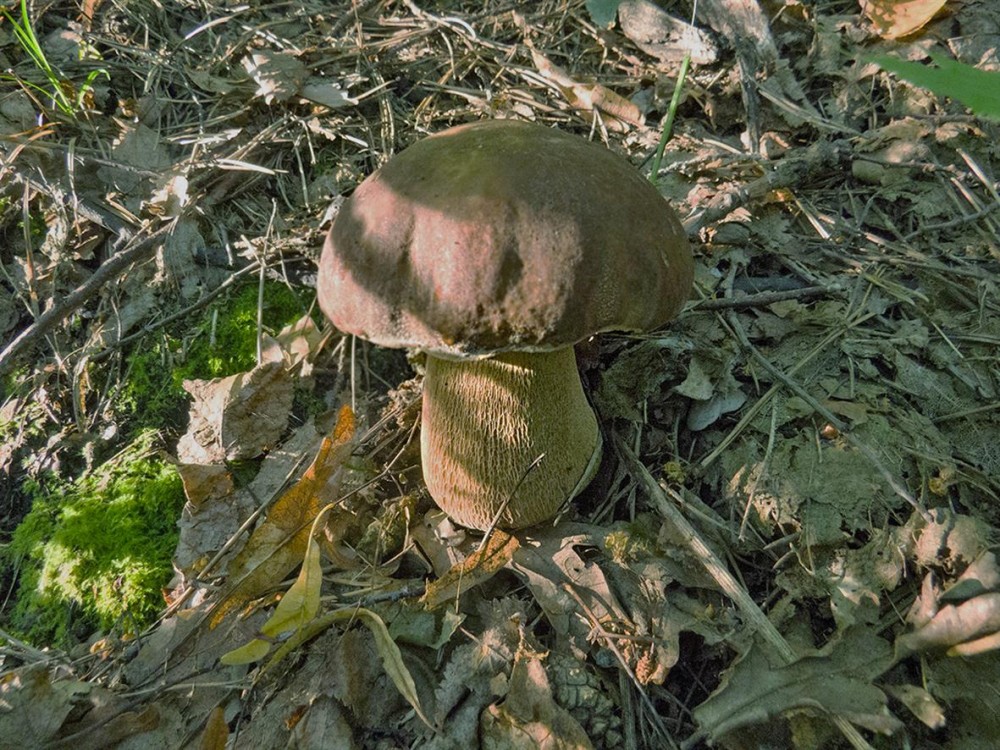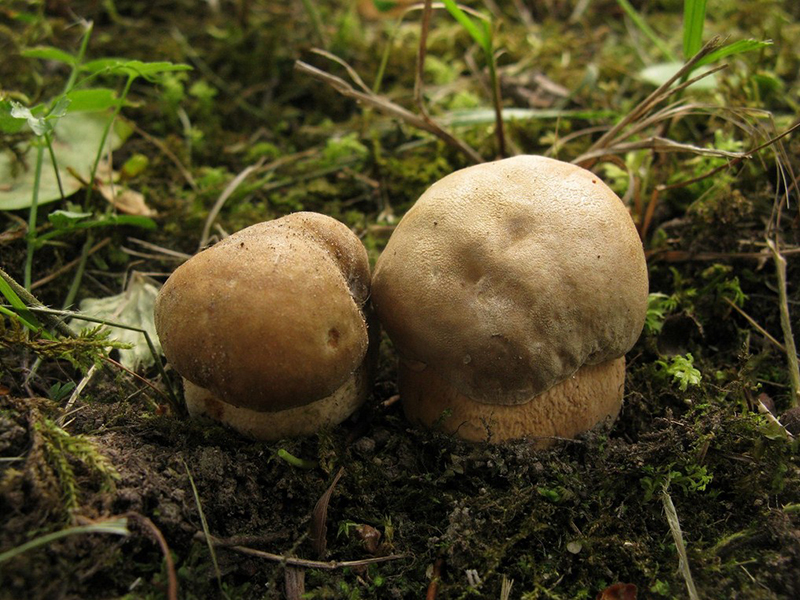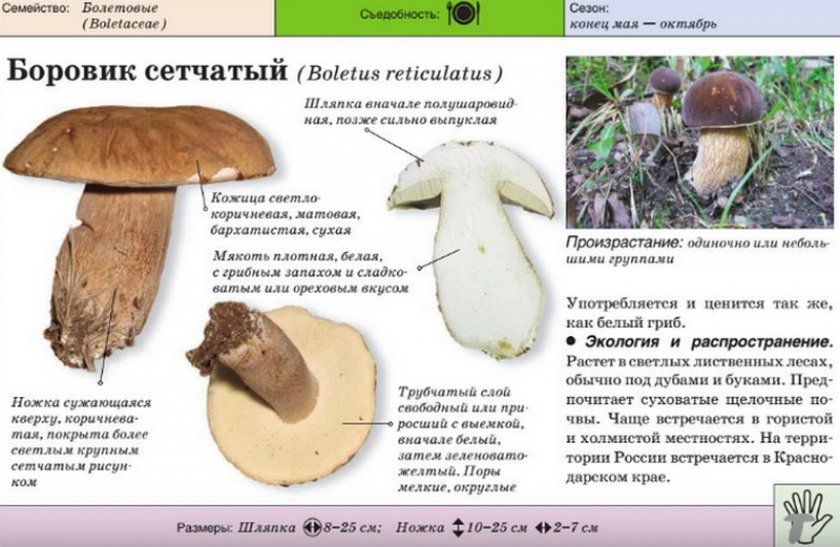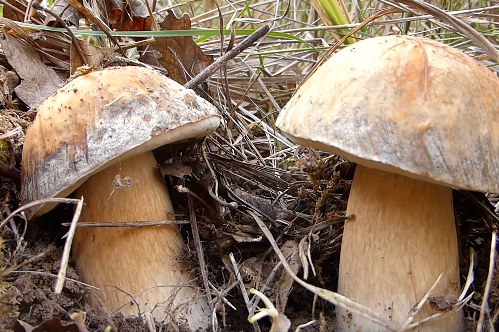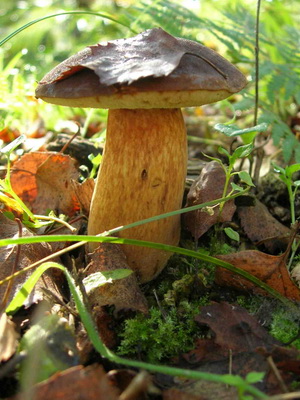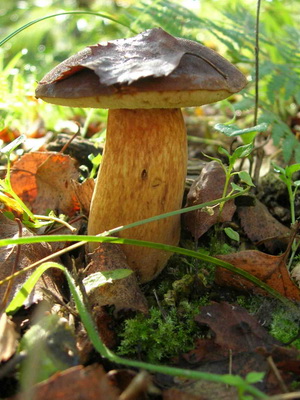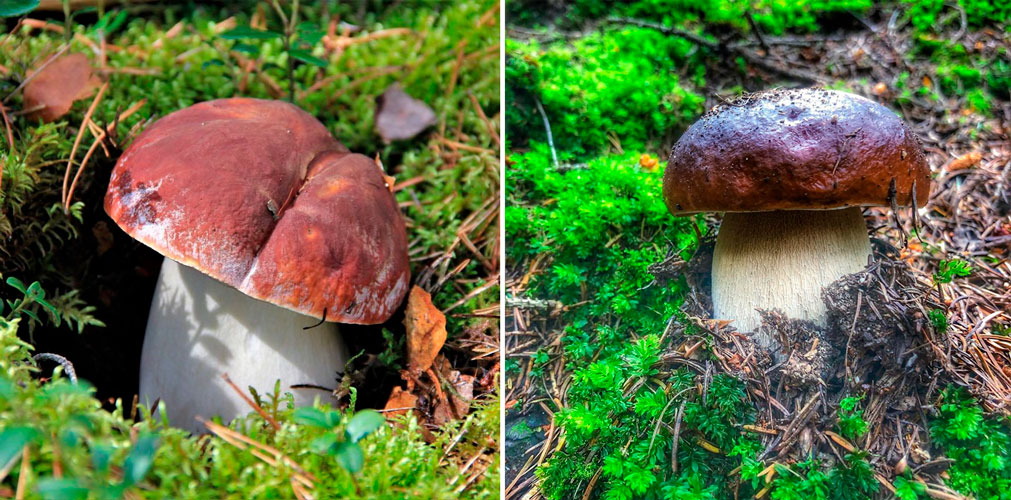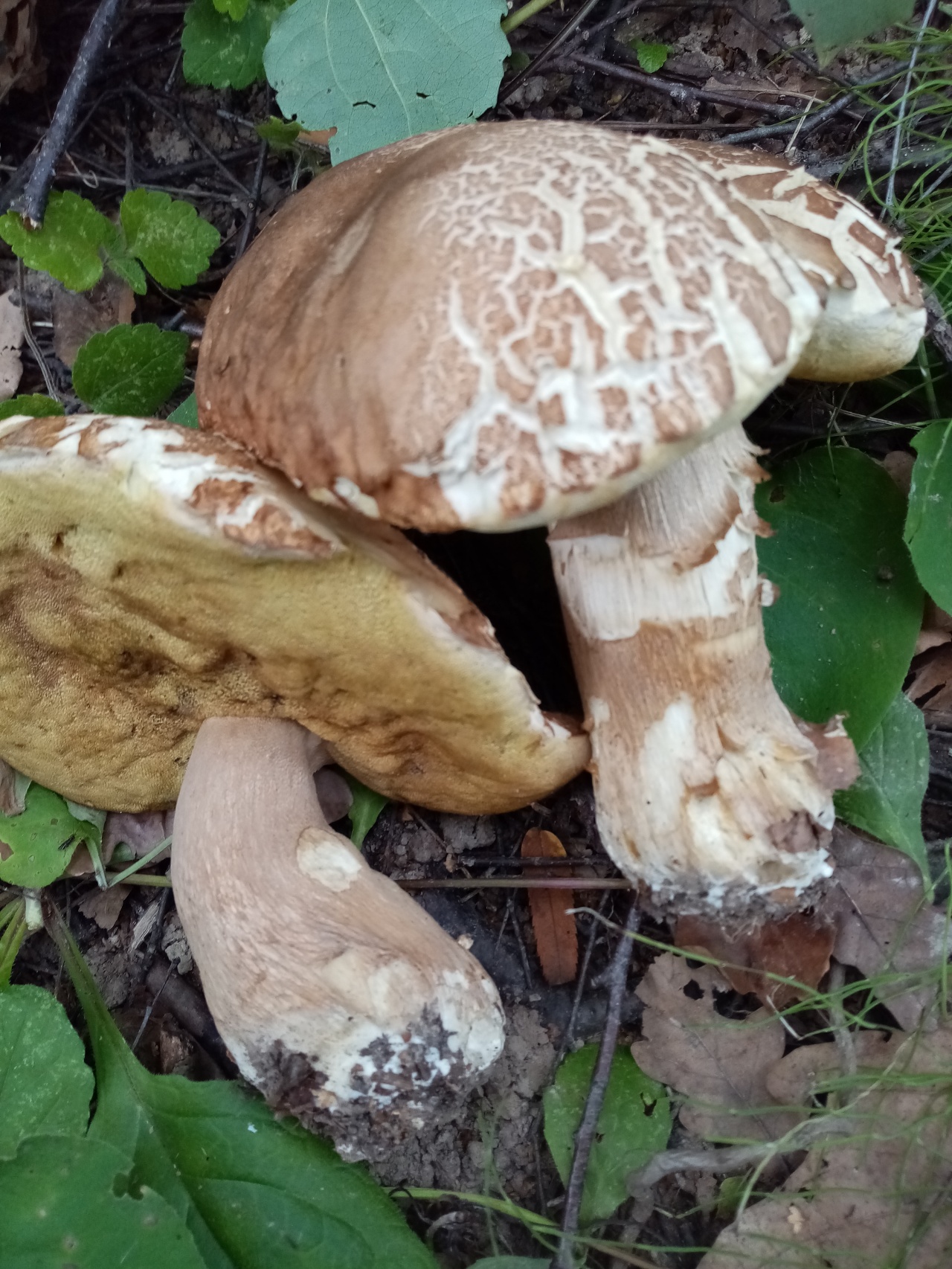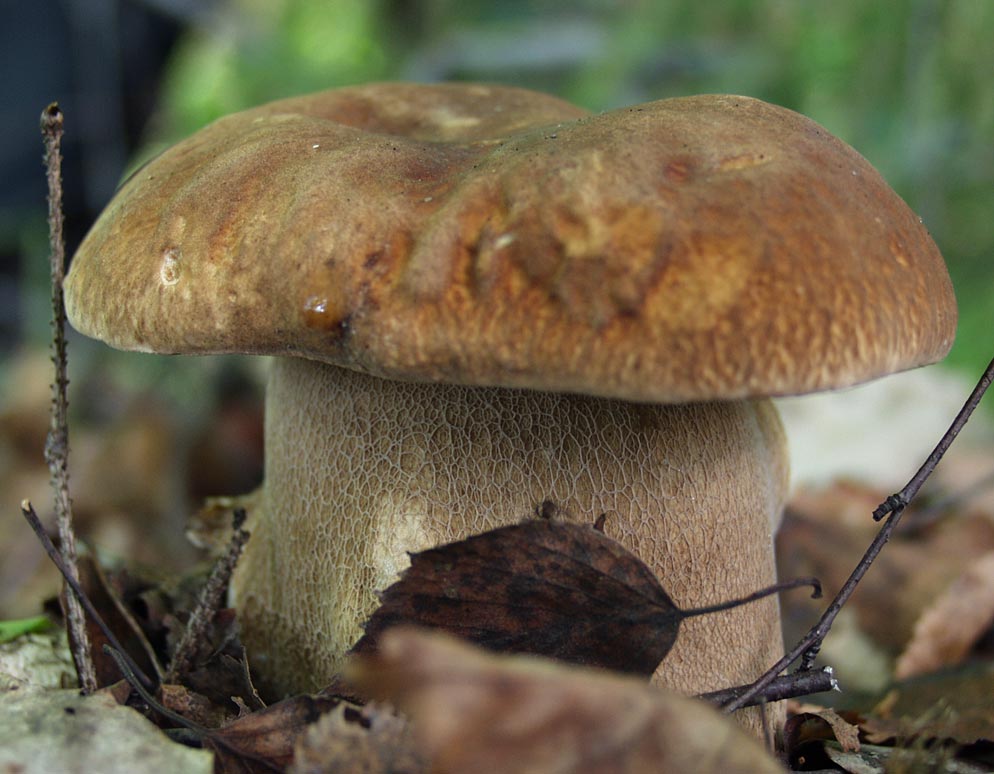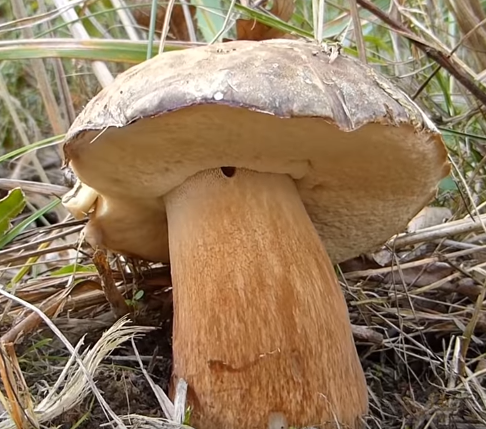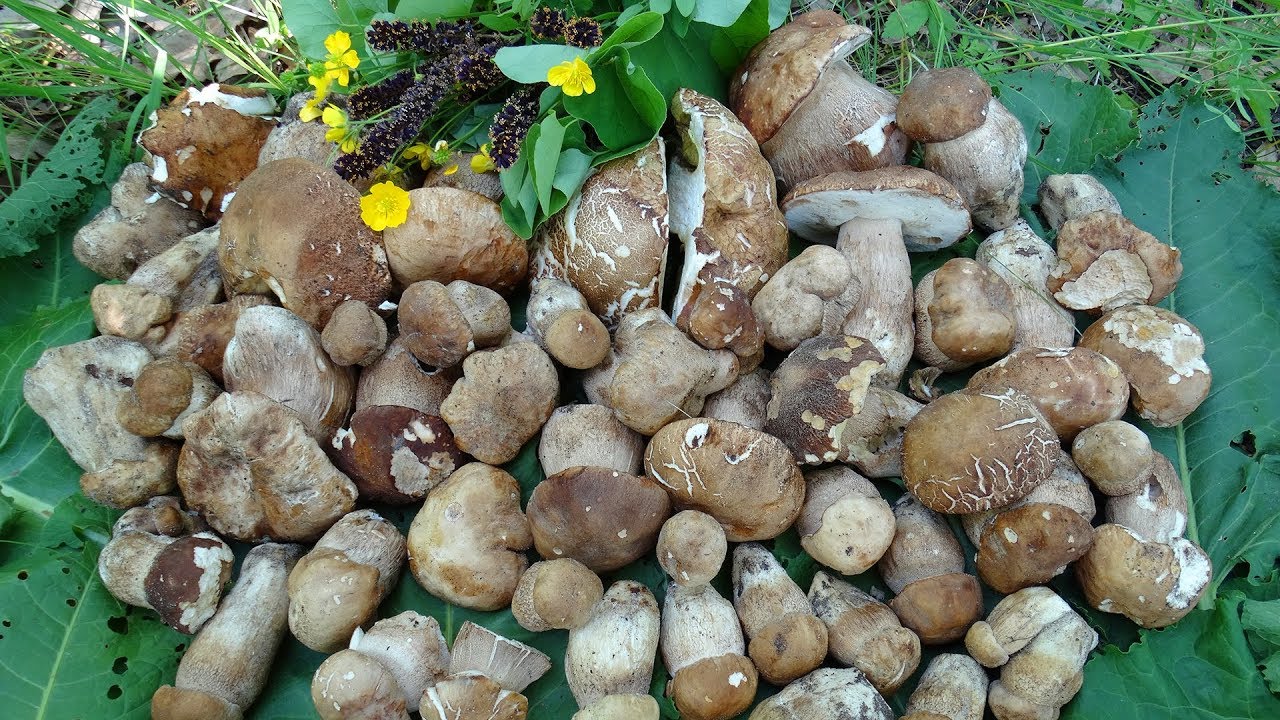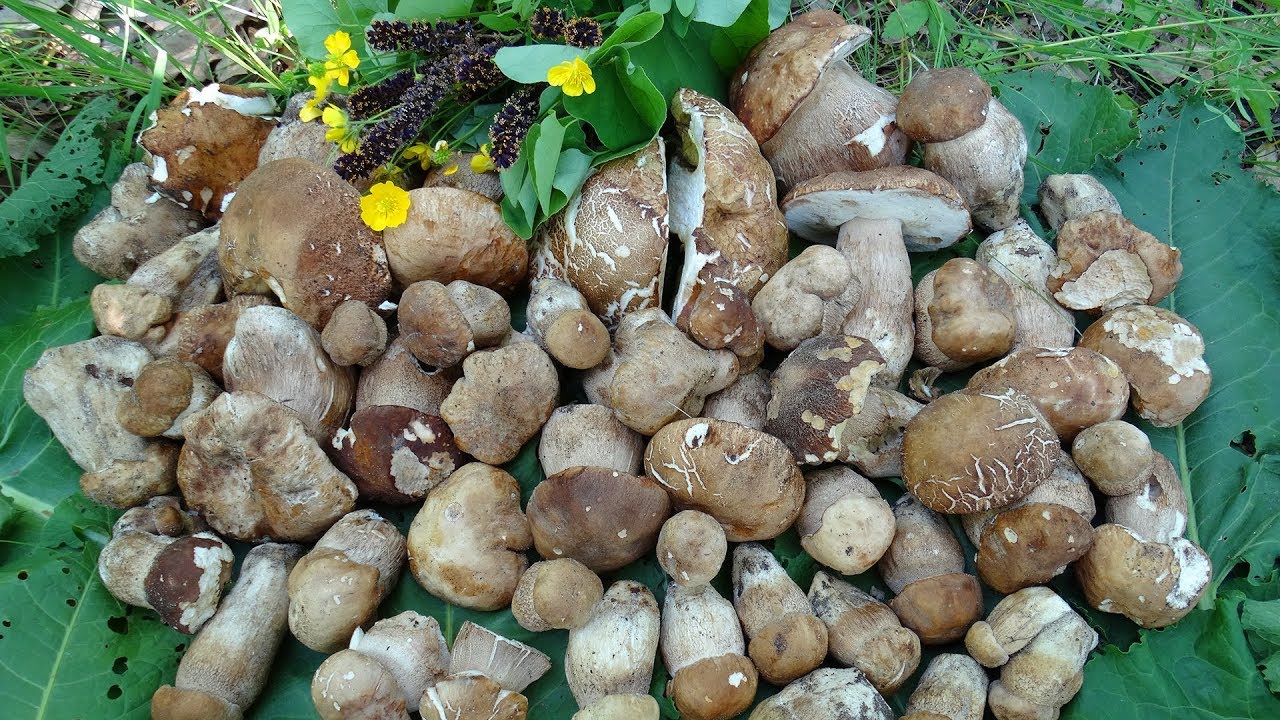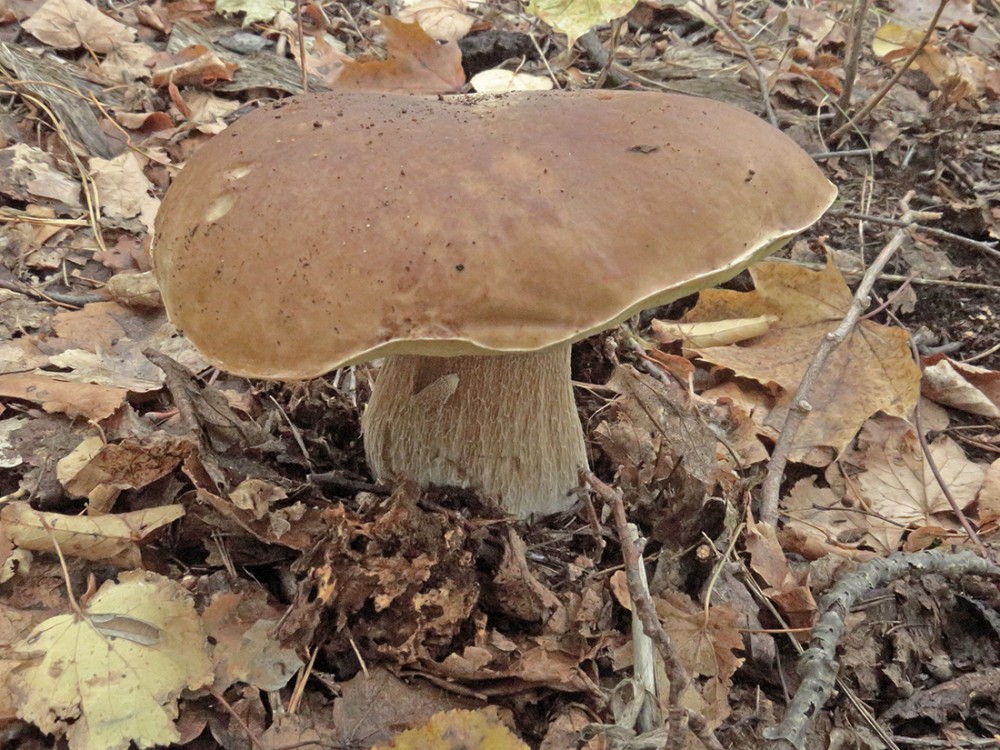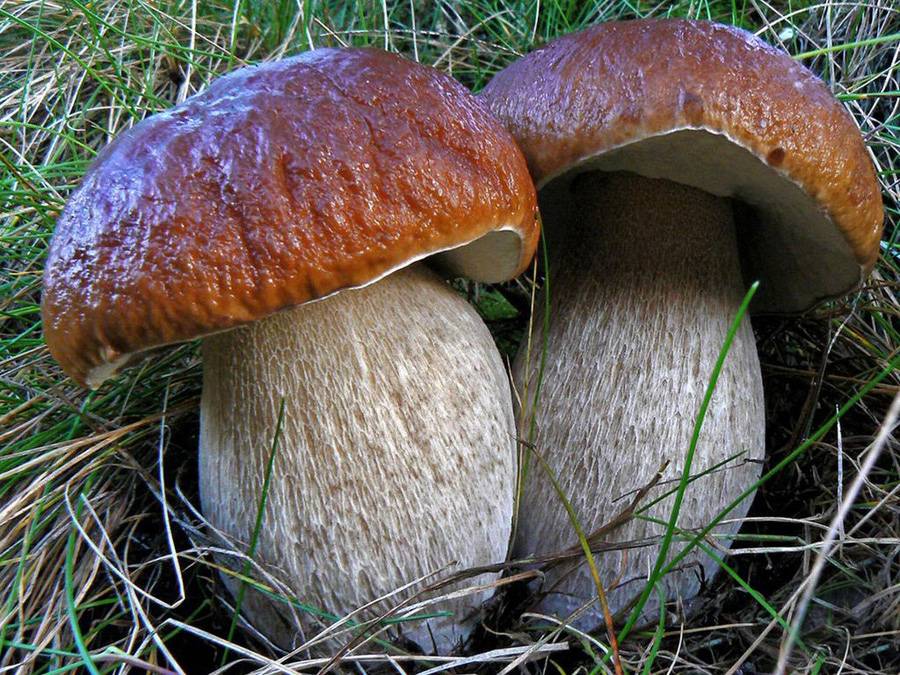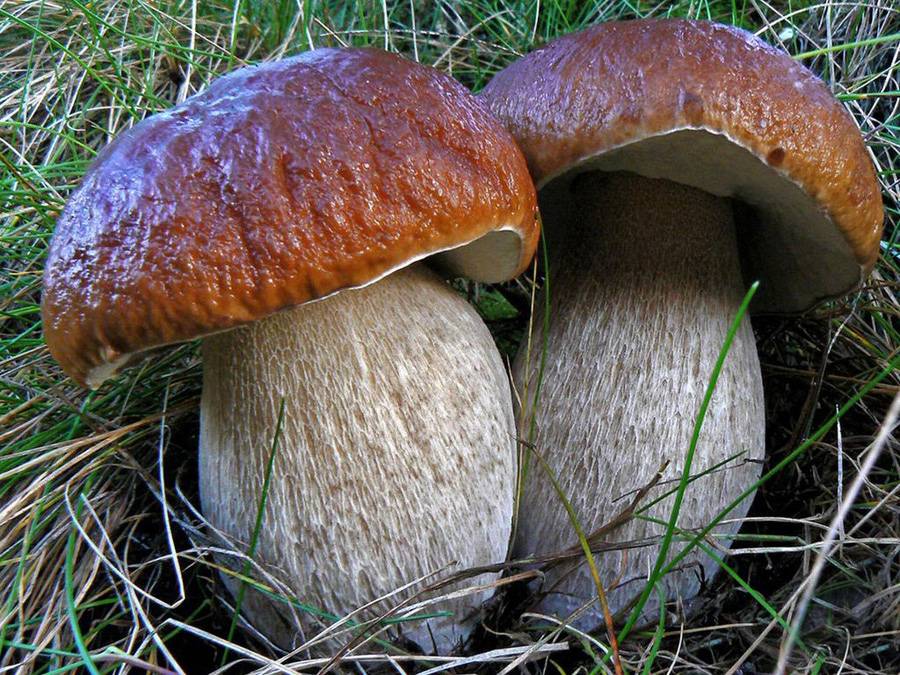Description of porcini mushroom
The cap of a mature porcini mushroom reaches a size of 7-30 cm in diameter (sometimes up to 50 cm), convex, flat-convex in old mushrooms, rarely spreading. The surface is smooth or wrinkled, in dry weather it can crack, naked, it can be thin (especially at the edge), rarely fibrous-scaly. In humid weather, the surface is slightly slimy, in dry weather, matte or shiny.
Skin color - from red-brown to almost white, darkens with age, can also be lemon-yellow, orange, purple tones, often uneven color, with light edges, sometimes with a narrow pure white or yellowish rim. The skin is adherent, does not separate from the pulp.
The pulp is strong, juicy-fleshy, fibrous in old specimens, white in a young mushroom, turns yellow with age, does not change color after cutting (very rarely there is a slight change in color to pink or blue), under the dark-colored skin there may be a layer of brown or red-brown shade. The taste is soft, weakly expressed, the smell of raw pulp is hardly distinguishable, a strong pleasant mushroom smell appears during cooking and especially during drying.
The leg is 8-25 cm high (usually up to 12) and up to 7 cm thick (rarely 10 or more), massive, barrel-shaped or clavate, stretches with age and can become cylindrical, widened or narrowed in the middle, the base often remains thickened. The surface is whitish, brownish, sometimes reddish, may have the same shade as the cap, but lighter. Covered with a net of white or lighter veins. The mesh is usually in the upper part of the leg, but it can also go down to the base, much less often it is absent or weakly expressed.
A tubular layer with a deep notch near the stem, easily separates from the flesh of the cap, light, white in young mushrooms, later turns yellow, then acquires an olive-green color, very rarely at a young age it happens with a pinkish-red tint. The tubules are 1-4 cm long, the pores are small and rounded.
There are no remnants of the bedspread.
The spore powder is olive-brown. The spores are fusiform, the average size is 15.5 × 5.5 μm, the sizes can vary quite a lot even in the same sample (11-17 × 4-5.5 μm), sometimes strongly elongated, up to 22 μm, but their width does not exceed the usual one.
Cystids are found in large numbers in young fungi, mainly on the surface of the hymenophore (cheilocystids), palisade standing, form a felt-like layer, which determines the white color of the young porous surface. After opening the pores, cystids are concentrated at the edges of the tubules. There are also cystids on the filaments of the mesh-like pattern of the stem (caulocystids) and on the surface of the cap (pileocystids).
Varieties
Boletus mushrooms grow everywhere in the forests of Russia, and there are a great many species of them. It can be seen that they are all from the same genus. They are distinguished only by the nuances of their appearance. All belong to the first taste category, each has an inedible double. Therefore, starting a "quiet hunt", carefully study the external signs of those mushrooms that are found in your area.
Pine
Its external features practically repeat the general description of boletus. What are the differences:
- The hat is red-brown with a diameter of 8-25 cm. The shade is purple.
- Pulp. Under the skin it is pink.
- The leg is very thick, short - up to 15 cm. Above there is a light brown mesh.
- The thickness of the tubular body is 2 cm. The shade is yellowish.
It has an early shape with a lighter head and flesh. Growth begins at the end of spring and continues until October. It settles under the pine trees - hence the name. With them, it forms mycorrhiza - fungus root. Occurs on sandstones, alone and in families.Distribution area - Europe, America, the European part of Russia.
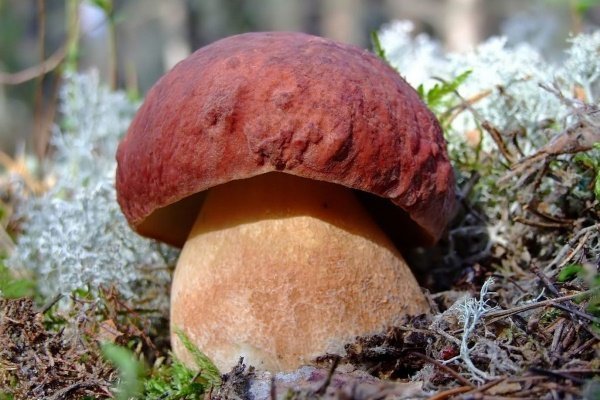
Birch
Its second name is spikelet. It is harvested when the earing of rye fields begins. Distinctive features:
- The hat is light yellow, 5-15 cm in diameter. The flesh has no pronounced taste. It does not darken at the break.
- The leg is barrel-shaped, with a light mesh.
- The thickness of the tubular layer is 2.5 cm. The shade is yellowish.
It prefers to grow under birches. They grow singly and in groups. Favorite places - on the edges, near the roads. Distribution area - Western Europe, Siberia, the Far East. The harvesting season is June-October.
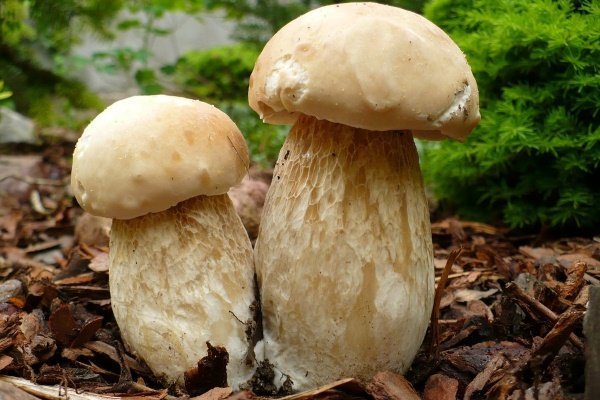
Dark bronze
Hornbeam or copper. Species differences:
- Rounded fleshy cap with a diameter of 7-17 cm. Dark shades. Sometimes cracked.
- The pulp is white. With a pleasant aroma and taste. In a fault, it changes color.
- Differs in a massive leg - it is pinkish-brown. Covered with brown mesh.
- Tubular layer 2 cm thick. Yellow, when pressed - turns green.
Grows in deciduous forests in warm climatic zones. Distribution - Europe, North America.
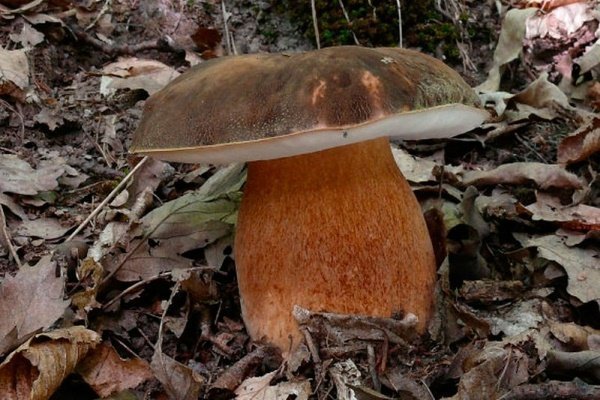
Other varieties
There are also such varieties of porcini mushroom:
-
Reticulate.
He has a brownish or light ocher cap. The leg is short, cylindrical. Can be confused with a flywheel. Prefers beeches and hornbeams. It grows in Europe, North Africa and North America. Has a pronounced mesh on the leg. Fruiting time is June-September. It is rare. -
Oak.
The hat is grayish. Sometimes there are light spots on it. It differs from other boletus in looser pulp. Prefers oak groves. Habitat - Caucasus, Primorsky Territory. It has a brown cap, very similar to a gall fungus. -
Semi-white mushroom.
The color of the cap is light brown or clay. Dense pulp - smells like carbolic acid. Distribution area - Carpathian region, Polesie, southern Russia. There is no mesh pattern on the leg. The hat is light brown.
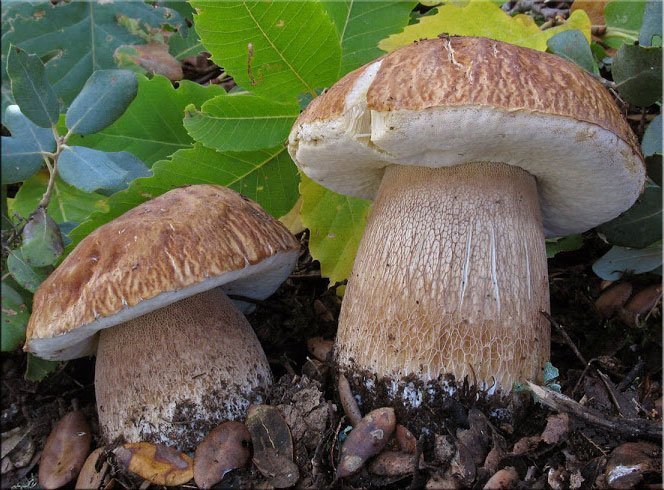
White mushroom net

White oak mushroom
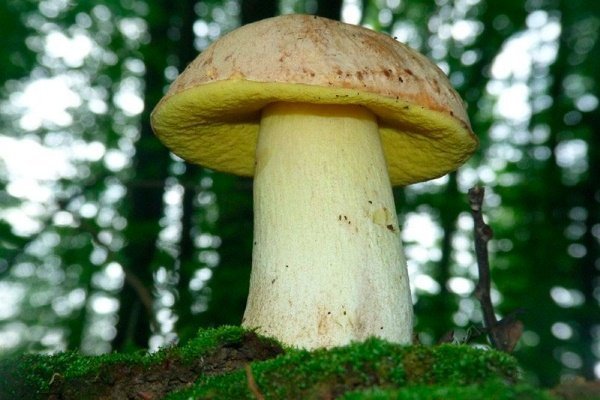
Semi-white type of porcini mushroom
Varieties
The types of porcini mushrooms differ not only in appearance, but also in the peculiarities of symbiosis with the roots of higher plants. They are found on soils with different compositions and in regions with different climatic conditions.
White mushroom net
This species prefers to grow on dry alkaline soils and bears fruit from June to September. It is often found in chestnut, beech and oak forests in Europe, America and Africa. The reticulated appearance has an external resemblance to the flywheel.
Distinctive features:
- the leg is short, has a cylindrical shape and a mesh pattern of a light brown shade;
- the cap is buffy or brownish, its diameter can reach 30 cm.
Old mushrooms may have small cracks in the cap.
White mushroom dark bronze
Has other names - copper and hornbeam. It is found in deciduous forests of warm climatic zones.
External description:
- the cap is dense, has a dark saturated color (in young mushrooms it is almost black) and a convex shape;
- the diameter of the cap is up to 17 cm, there may be cracks on the smooth peel;
- pinkish-brown stem of cylindrical shape, has a thickening at the bottom.
The tubular layer (hymenophore) in young fungi is almost white, later it can turn light yellow. When pressed, a greenish tint appears. The species bears fruit from July to October, in some regions it can be found from May.
Birch white mushroom
It grows under birches, the fruiting period lasts from early summer to October. It appears in the forest when the ears of grain crops are ripening, therefore it is also called a spikelet.
External differences:
- a light-colored hat has a diameter of up to 15 cm;
- the hymenophore is yellow;
- the white leg resembles a barrel in shape, there is a pattern of a light brown shade on it.
When cut, the pulp does not have a bright aroma.
Pine mushroom
This type is found on sandy soils. Fruiting more often near pine trees, in rare cases it can grow under spruce and deciduous trees.Found in pine forests in Europe, Asia and America.
Distinctive features:
- the diameter of the cushion cap can be up to 25 cm;
- the surface of the cap is red-brown with a lilac tint, there is a light edging at the edges;
- the tubular layer is yellowish;
- the thick leg is strongly thickened towards the base, covered with a cream-colored pattern.
Fruiting from early summer to September, can occur from late spring.
White oak mushroom
A feature of the oak species is the brown color of the cap with a grayish tint. Other features:
- loose pulp;
- there may be light spots on the cap;
- grows in large groups.
Occurs from early summer to mid-autumn. Habitat - oak forests of the European part of Russia, Primorsky Krai, the Caucasus.
Spruce white mushroom
The most common variety found in fir and spruce forests on various continents, except Iceland and Australia. It can also bear fruit under deciduous trees. The fruiting period is from June to October.
External characteristics:
- the hat has a convex shape, brown or chestnut shade (diameter - up to 30 cm);
- the peel is velvety to the touch, does not separate well;
- the hymenophore is light yellow in color;
- the leg is light brown, thickened in the lower part.
The development of the spruce species is favorably influenced by warm nights, fogs, thunderstorms, as well as the presence of sandy soil and loam. The spruce mushroom often prefers an open area that is well warmed up by the sun's rays. Grows in old forests with an abundance of moss and lichens.
Other varieties
Another variety is the royal mushroom (king), found on soils with an abundance of limestone and sand. This is a tasty and aromatic species, its distinctive features are a bright expressive hat and a yellowish stem. When broken, the flesh of the royal boletus acquires a bluish tint.
There is a rare species - a semi-white mushroom, which is more common in the Carpathian region and southern regions of Russia. Its cap has a clay-brown hue, the pulp, when cut, emits a specific smell of iodine. According to its taste characteristics, the semi-white mushroom is assigned to category 3.
When and where does it grow?
The distribution area of boletus is striking - they are found on almost all continents. The exceptions are Antarctica and Australia. Japan, Mexico, Mongolia, North Africa, the Caucasus - boletus grows everywhere. You will not find him unless in Iceland. In Russia, it grows almost everywhere - from southern latitudes to Kamchatka. Spruce boletus is found in spruce and fir forests.
Each locality has its own terms of fruiting. In warm zones, the mushroom begins to grow in May-June, and bears fruit until October-November. In the north, the growth period is from June to September. It has a long growth phase - to reach maturity, it needs to grow for a whole week. It grows in families, rings. Having found one specimen, you need to carefully explore the nearby space - there will probably be a few more pieces.
Prefers to grow in forests:
- conifers;
- deciduous;
- mixed.
It grows more often under spruce, fir, pine, oak and birch trees. Where to find them:
- in places overgrown with lichen and moss;
- loves old forests;
- can grow in the shade, but the sun does not bother him either - he prefers heated areas.

It doesn't grow:
- in wetlands;
- in peat bogs.
Rarely found in forest-tundra and steppe. His favorite soils:
- sandy;
- sandy loam;
- loamy.
Mushroom pickers tell how to find boletus in the forest-steppe conditions. You will discover the secrets of mass harvesting, and where the porcini mushrooms are hiding:
Harm and contraindications
Mesh boletus should be chewed well, because they are already hard to digest in the stomach. They should be consumed in moderation. The digestive system of young children is too vulnerable and unable to cope with heavy food, so it is not recommended to include mushrooms in their diet. It is better to gradually introduce them into the children's menu after 10 years.
Even an edible mushroom can pose some kind of danger to human health. After all, this product has a high degree of sorption, it can absorb toxic substances, as well as salts of heavy metals. Therefore, it is not advised to buy oak porcini mushrooms from private traders, because they could be collected near highways or industrial facilities. Following all the recommendations, you can enjoy delicious and healthy mushrooms all year round without harm to your health.
Types of porcini mushroom
Birch cep (Boletus form betulicolus) or Boletus edulis form betulicola. It is distinguished by a light, to almost white color of the cap and growth under birches.
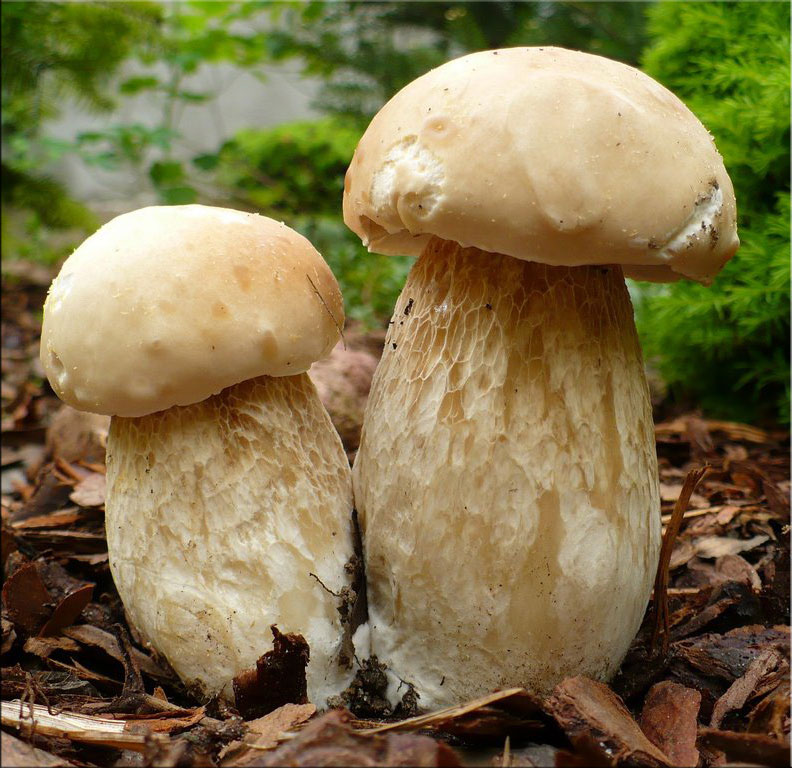
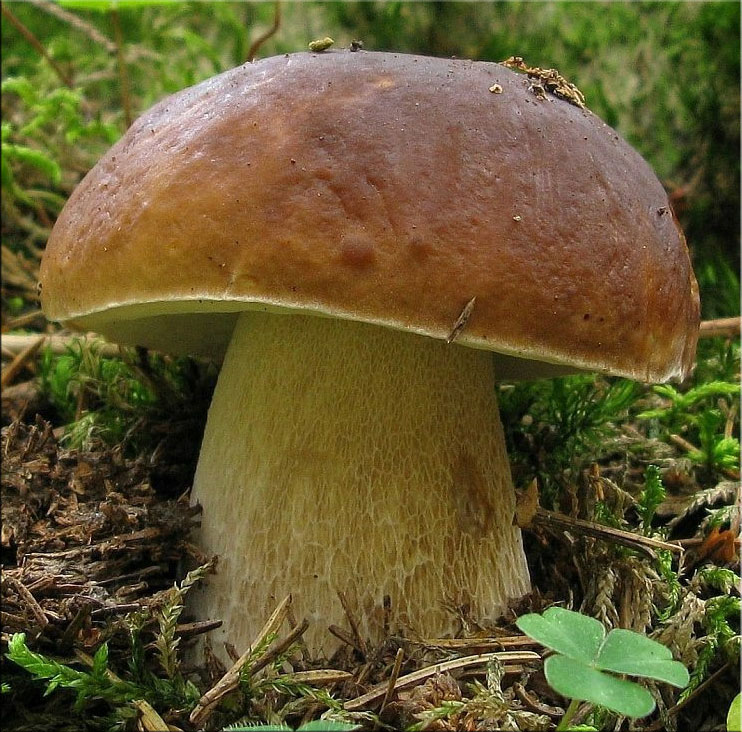
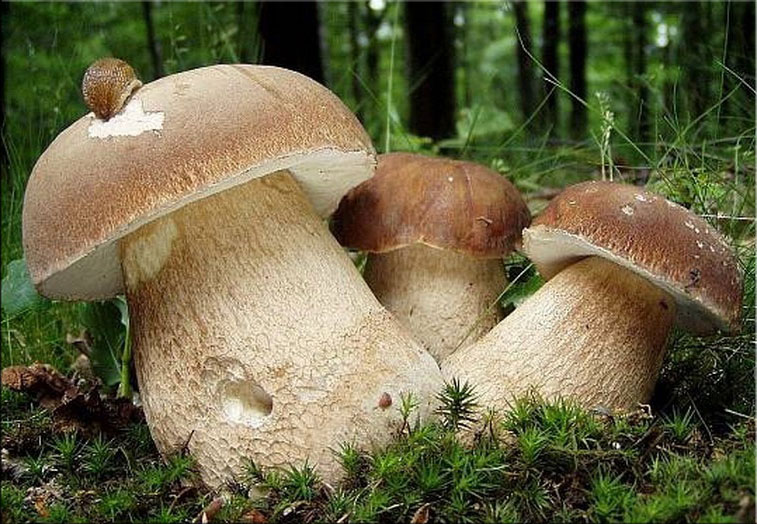

Spruce mushroom (Boletus edulis form edulis). The edge of the cap is leathery, sharp. The top is convex, brown. The tubular surface is light yellow or olive yellow. The length of the tube is 1-4 cm. The leg is dense, clavate, in the lower part it has a mesh pattern. The pulp is dense, white, does not change color when cut, has a pleasant smell.

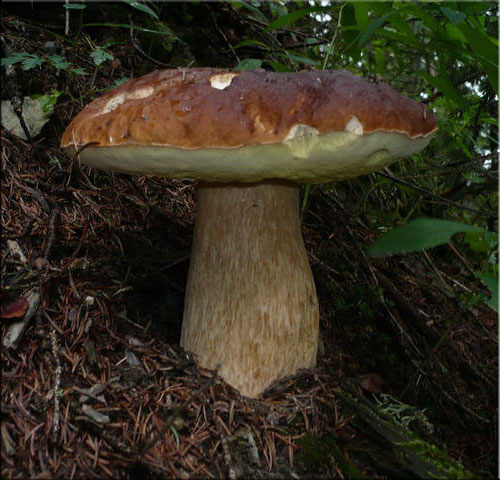

Pine cep (Boletus form pinophilus), or a variety of upland (Boletus edulis form pinicola). This form has a large dark cap, sometimes with a purple tint. The flesh under the skin is brownish-red.


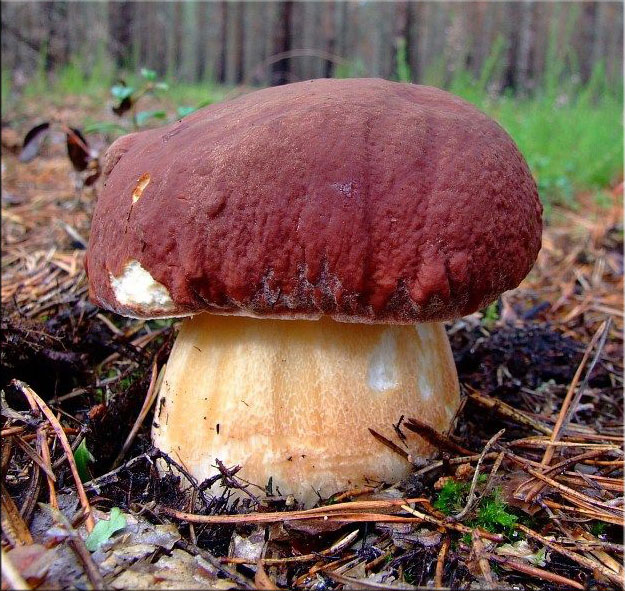
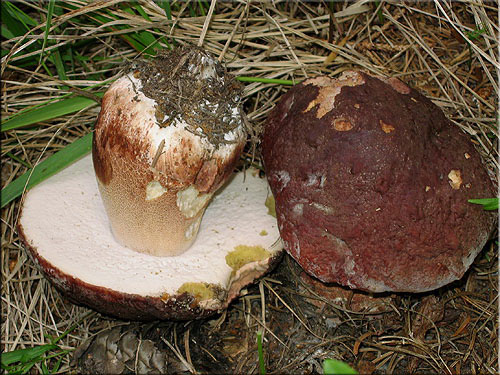
Dark bronze white mushroom, or hornbeam (Boletus aereus or Boletus edulis form aereus). A very dark colored mushroom, almost black in color, grows in beech and oak forests. It is found in Europe, in more western and southern regions (from Spain to Western Ukraine) and in the USA.
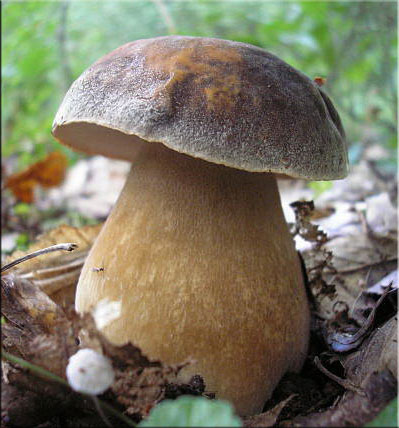


Cep mushroom (Boletus reticulatus) or Boletus edulis form reticulatus. This form has a light-colored brownish or ocher cap and a short cylindrical stem that looks like a flywheel. Grows with beech and hornbeam in Europe, Transcaucasia, North America and North Africa. Occurs in June - September, not often and not abundantly.
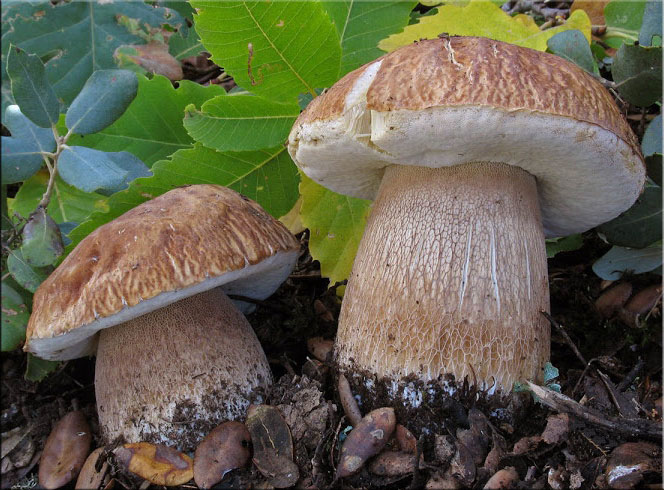
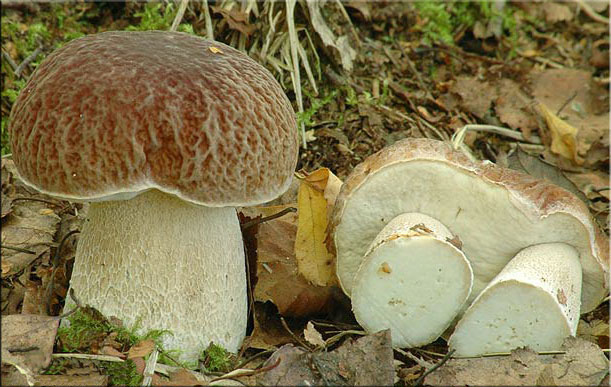
Oak cep (Boletus edulis form quercicola). The oak form of the porcini mushroom is more thermophilic, it is massively found in the summer in broad-leaved, oak forests. The color of the cap is grayish-brown with whitish spots, the stem is rather long, thickened towards the base, the same color as the cap with a weak mesh along the entire length of the stem. In oak forests, a bronze form also grows with a small wrinkled bronze-brownish-brown cap with a darker top, with a gray-fawn leg and an inconspicuous mesh pattern almost along the entire not thick leg.
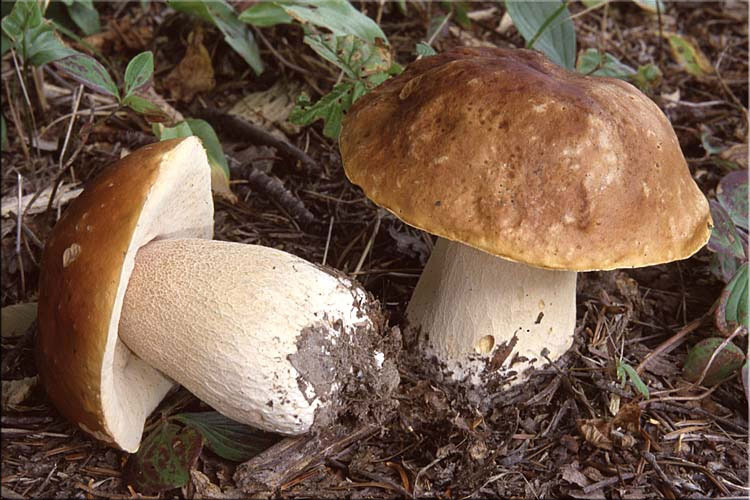
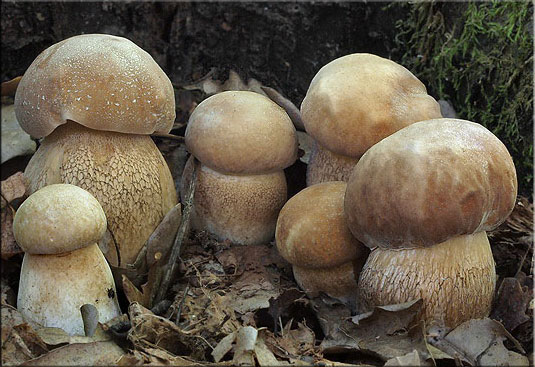
Description of boletus net
The diameter of the cap of the white oak mushroom is 8-25 centimeters, but in large specimens it can reach 30 centimeters. The hat is covered with a slightly velvety skin. In dry weather, the caps crack, sometimes a characteristic mesh pattern appears. The color of the caps is very variable: brownish, coffee, gray-brown, ocher, sometimes there may be whitish spots.
The tubes are thin, free. The edges of the tubes in young specimens are white, then yellow-green or olive-green. Spores are honey-yellow or brownish. Spore powder, olive brown.
The length of the boletus mesh leg is 10-25 centimeters, and its diameter ranges from 2 to 7 centimeters. At first, its shape is cylindrical, but with age it most often becomes clavate. The entire length of the light-nut leg is covered with a pronounced brownish or white mesh.
The flesh of these mushrooms is dense, but with aging it becomes a little spongy, especially for the leg. If you press on the leg, it seems to spring. The color of the pulp is white, it does not change in air. Under the tubular layer, the flesh may be yellowish. The aroma of the pulp is pleasant, mushroom, and the taste is sweetish.

The spread of porcini oak mushrooms
White oak mushrooms are one of the earliest species and can be found as early as May. And they continue to bear fruit until October.
They grow in deciduous forests, most often found under beeches, oaks, lindens, hornbeams and edible chestnuts. These mushrooms prefer warm climates. They are usually found in hilly and mountainous areas.
The similarity of boletus reticulum with other mushrooms
Mesh boletus can be confused with other types of porcini mushroom, for example, in the white pine mushroom, the leg is also with a net, but it is only present in its upper part.
Beginners can confuse the mesh boletus with a gall fungus, but you can recognize it by a black mesh and a pinkish hymenophore, in addition, bile fungi grow in coniferous forests.

Evaluation of the taste and beneficial properties of the white oak mushroom
Boletus reticulated is considered one of the best mushrooms. When dried, it is very aromatic. These mushrooms can be pickled and consumed fresh.
White oak mushrooms have long been famous for their healing properties, with their help in Russia, they treated tuberculosis and ulcers. The mesh boletus contains hercynin, which has a beneficial effect on the work of the heart. There is evidence that mesh boletus has an anticarcinogenic effect. These mushrooms are useful raw in a variety of salads.
Other mushrooms of this genus
Boletus Fechtner grows in deciduous forests, on calcareous soil. These mushrooms grow in the Far East and the Caucasus. They bear fruit from June to September.
The diameter of Fechtner's boletus cap is 5-15 centimeters. Its shape is hemispherical, but with age it becomes flat. The color is silvery white or pale brownish. The leg is 4-15 centimeters long and 2-6 cm thick. The lower part of the leg may be slightly thickened. The color of the leg is yellowish, while the base is red-brown.

Fechtner's boletus are edible mushrooms. They can be consumed canned, salted and fresh. In terms of taste, they belong to the 3rd category.
Porous boletus has a convex cap with a diameter of no more than 8 centimeters. The skin on the cap most often bursts, resulting in a reticulated whitish pattern on the surface. This mesh is a distinctive feature of porous boletus. The color of the cap is gray-brown or dark brown. The stem is also gray-brown in color, and its lower part is darker.
Porcotic boletus most often grow in coniferous and mixed forests. They settle on moss or among the grass. The fruiting season lasts from summer to autumn. These are edible mushrooms.

Where the whites grow
Favorite places where porcini mushrooms grow are dry sparse birch groves, pine forest or spruce forest located on a somewhat elevated site. The forest, in which boletus mushrooms are found, is not very light, cool, but also not damp, not dense. You will never find a porcini mushroom in damp wetlands, in too damp and high moss, on hummocks, in high thickets of blueberries and lingonberries. Porcini mushrooms do not grow in dense dense more often, they do not like direct sunlight. Most often, boletuses hide among low grass, under leaves or where fallen needles lie in a thick, soft layer.
If the summer is humid, rainy, you should look for boroviks on the heights, where it is not very damp. In dry summers, they are found in hollows, where it is cooler and more humid.
White time
The time of the appearance of boletus can be determined by the appearance of fly agaric. Look closely, if you see one boletus, look for another and a third nearby. Boletus grow in whole families. In one place, if no one has been there before, you can find 10 ... 15 mushrooms.
Porcini mushrooms grow from June to October, but if the summer is humid and warm, they can be found earlier. Autumn porcini mushrooms are considered the best in terms of nutritional value. Like all mushrooms, boletus grows quickly. If a fungus that has just emerged from the ground weighs 2 g, then after a week its weight increases to 200 g. handsome heroes are most often unsuitable for food: overgrown mushrooms have a lot of fiber that cannot be absorbed by the human body, in addition, they, as a rule, are affected by worms.
Growing boletus
Cultivation of boletus is a painstaking occupation that requires patience and special conditions. Due to its biological properties, the fungus needs a close connection with the root system of trees. For successful cultivation, it is necessary to plant spruce, pine or birch on the site, then you can start breeding boletus in any of three ways:
- Crushed boletus is soaked in water for a day, mixed and filtered. The finished infusion containing boletus spores is carefully distributed under the trees.
- Separate plots of land containing mycelium are dug in the forest. Small depressions are made in the soil under the trees in the garden, where the mycelium is placed and covered with forest soil. The mycelium needs moderate watering.
- The caps of overripe boletus are cut into small slices and mixed with moistened soil, and then laid out under the trees.
With timely watering for the next year, you can get a harvest: first, individual boletus, then whole families.
Description of Boletus Mesh
In order to recognize the boletus reticulum in the forest, you need to have an idea of its appearance. From Latin - BOLETUS RETICULATUS. For many, the usual name is White mushroom Oak or Reticulated form.
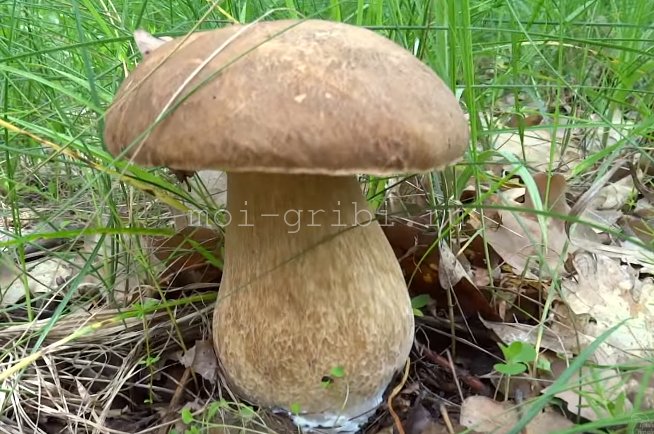
Hat
The mushroom cap is large enough. Its diameter ranges from 8 to 25 cm, depending on the age of the fungus, as well as on the conditions in which it grows.
In some cases, with well-established external factors, namely the weather and a good location, the mushroom cap can grow up to 30-35 cm.
It is covered with a soft velvety skin, pleasant to the touch. Droplets of moisture collect on it.
If the summer is excessively dry, hot, and the mushroom grows in a clearing open to sunlight, then the texture of the cap begins to crack. A mesh pattern appears. Small insects find their refuge there.
As for the color of the cap, it changes depending on the location of the growth of the fungus. Distinguish between dark brown, gray-brown, coffee and ocher color. Sometimes, with a lack of nutrients, white spots appear on the mushroom cap, which can grow over time.
If you look under the cap, you can see very thin, almost transparent tubes that do not connect to each other.
Their edges are white, but the older the mushroom, the darker the tubes become. Colors can range from yellow-orange to green, and spores have a yellow or orange tint, less often brown.
Spore powder is brownish or olive in color.
The hat does not fit snugly on the leg and may fall off at the slightest careless movement.

Leg
The leg of this mushroom can reach a length of 10 to 25 cm. The diameter also varies from 2 to 8 cm. In most cases, a cylindrical shape of the leg is observed, however, with age, it becomes thinner at the cap and grows at the roots.
The color of the leg in young mushrooms is white, and in older mushrooms it has a light nutty tone. It has a brown mesh on it.
The flesh of the leg of this mushroom is quite dense, however, the older the mushroom, the more spongy it has.
How do you know if a mushroom is good for food? This is checked by the leg. To do this, you need to put good pressure on it. If the stem is bouncy, it means that the mushroom is edible.
Even in an old mushroom, when cut, the flesh has a white tint. Even outdoors, its color does not change.
Deep under the tubular layer, the flesh may also have a yellowish tinge.
She has her own kind of pleasant mushroom smell. Has a sweet taste.
Habitat
This mushroom can be classified as an early appearing species. That is why the first white mesh boletus can be found in May. Keep a close eye on their location, as mushrooms may appear in the mycelium even before October.
Basically, the white oak mushroom is concentrated in deciduous forests. It prefers to appear under linden, beech, oak and chestnut trees.
Mushrooms will not appear in cold climates, they are lovers of high temperatures, moderate moisture.
Most of them are found in hilly or mountainous areas. It can often be found in central Russia.

Pulp
The flesh of the mushroom cap is different from the stem. It has no sweet aftertaste, rather a little salty. The pulp is easily separated, has a white tint. In older mushrooms, it is yellowish, with small splashes. Has a characteristic mushroom smell.
After boiling, the pulp becomes soft, cutlery is literally buried in it.
When pressed, the good pulp should spring, if this does not happen, the mushroom is either too old or devoid of moisture, as a result of which the taste could be damaged.
Fruiting period
You can start looking for mushrooms in mid-May, when frosts pass and the sun begins to appear. Boletus appears very quickly, so literally a few days after the settled sunny weather, you can go in search. The largest number of mushrooms occurs in June-July.
But in August - September and even early October there are fewer mushrooms, but still, they appear in forest glades, where the sun is active.
The value and benefits of the mushroom
Borovik is the most valuable food product. The calorie content of raw boletus is 22 kcal per 100 g. Ingredients:
- proteins - 3.1 g;
- carbohydrates - 3.3 g;
- fats - 0.3 g;
- dietary fiber - 1 g;
- water - 92.45 g;
- ash - 0.85 g.
Boletus is just a storehouse of all possible vitamins, minerals and other useful substances. This is a valuable product that combines taste and useful properties. Porcini mushrooms have everything the body needs, including:
- Selenium. There is so much of it in the pulp that the consumption of mushrooms is able to resist cancer in the early stages.
- Ascorbic acid - normalizes the work of all organs.
- Calcium, iron, phosphorus and other vital elements.
- Phytohormones - eliminate inflammation.
- B vitamins - strengthen the nervous system, help normalize energy metabolism, improve memory and sleep, prevent infection, increase mood and appetite.
- Riboflavin - normalizes the thyroid gland, promotes hair and nail growth.
- Lecithin - useful for patients with atherosclerosis, anemia. Cleans blood vessels from cholesterol.
- B-glucan is an antioxidant that protects the immune system, saves the body from fungi, viruses, bacteria.
- Ergothioneine - renews cells, restores the liver and kidneys, is useful for bone marrow, improves vision.

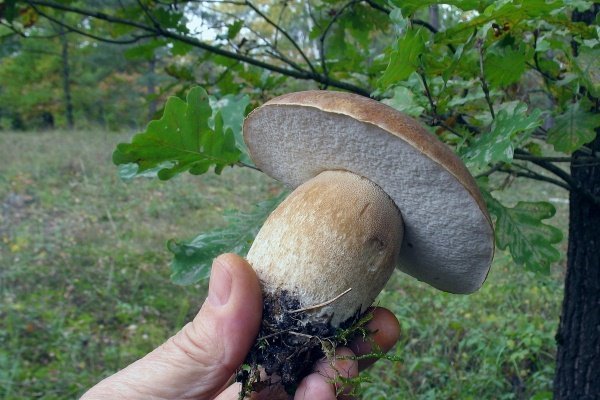
Calorie boletus
Boletus are not only low-calorie foods that allow them to be included in the diet of everyone who is trying to lose weight, but also very useful gifts of the forest: the content of vitamins A, B1, C and D in large amounts, as well as amino acids, sulfur, lecithin, riboflavin and polysaccharides is responsible for the normal functioning of the whole body and, in particular, the thyroid gland, and also helps to fight cancer and strengthens the immune system.
Calorie table (per 100 grams of mushrooms):
- Caloric content …………… .. 22 kcal
- Proteins …………………………. 4.0 g
- Fats …………………………. 1.5 g
- Carbohydrates …………………… 1.1 g
- Water …………………………… 90%
However, one should not forget that excessive enthusiasm for boletus is fraught with a large load on the digestive system, so you need to know the measure so as not to harm your health, but to use these tasty mushrooms for your own benefit and pleasure.
Contraindications
Porcini mushrooms are an amazing gift of nature, many useful substances are presented in their tissues in a concentrated form. The ability to accumulate elements can be harmful - the fruiting bodies collect and retain, like a sponge, salts of heavy metals and toxins. Old specimens are especially prone to this, therefore it is undesirable to collect them.
In addition, one should refrain from quiet hunting along highways and near factories, and when leaving the city, you need to find out in advance how the wind rose is located and avoid directions where the wind carries industrial emissions.
Mushroom dishes, which are generally considered heavy food, are not recommended for children under seven and pregnant women.
Low acidity of gastric juice, metabolic disorders and pancreatic function are also contraindications to the use of these saturated foods.

